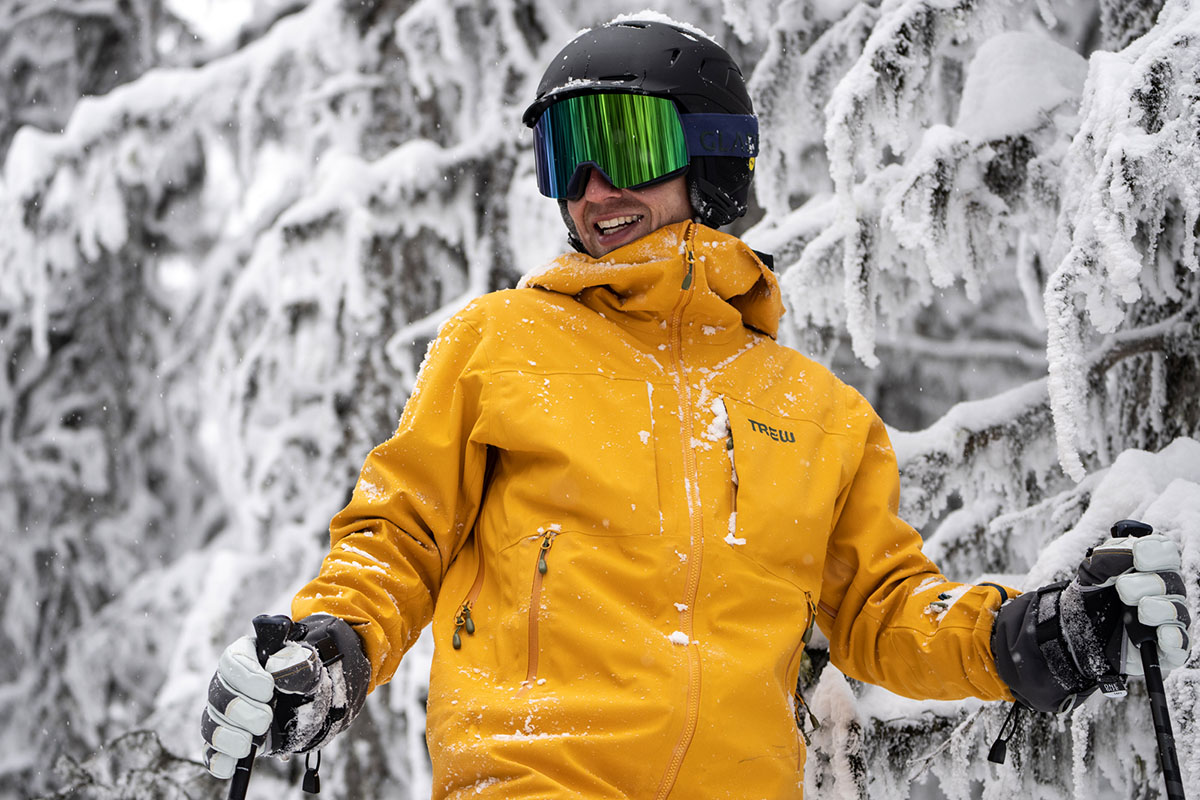

Switchback Travel (Jason Hummel)
Choosing the right ski jacket is all about managing the conditions that you might encounter on the mountain. This depends on the specific kinds of skiing you enjoy most—bracing against a Nor’easter on a lift in Maine is far different than skinning up a sunny ridgeline in the North Cascades. Some people prefer a shell for the versatility, and some prefer a bit of insulation to keep the cold at bay. Budget-seekers like the all-in-one functionality of a 3-in-1 jacket, which comes with a separate insulating layer that can be zipped into the shell. We’ve included all three in our picks for the best ski jackets of the 2025 season below. For further guidance, see our comparison tables and buying advice below the picks, along with details about our testing process. And for a wider look at the market, we’ve also compiled round-ups of the best men’s ski jackets and best women's ski jackets.
Editor’s note: We updated this guide on March 12, 2025, to make it unisex, providing a more even split between men's and women's models. This involved revamping many of our product blurbs to reflect key differences between styles and adding several women's-specific designs to our list.
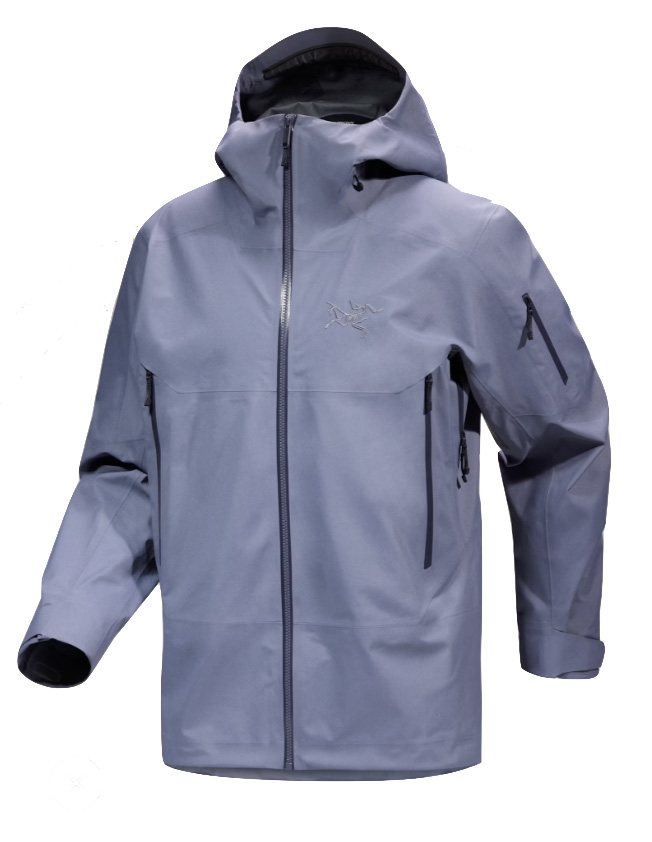 Best for: Resort/backcountry
Best for: Resort/backcountry
Type: Shell (flannel backer)
Waterproofing: 3L Gore-Tex ePE
What we like: Everything we look for in a quality all-rounder.
What we don’t: Committed backcountry riders will likely want a lighter, more packable, and more breathable jacket.
Over the years, we've come to rely on Arc'teryx gear for trusted performance in harsh weather, clean-looking designs that hold up well over the long term, and keen attention to detail. The men's Sabre and women's Sentinel ski jackets check all of these boxes emphatically. As far as protection goes, the 3-layer Gore-Tex ePE membrane is highly reliable in rough and rowdy weather, and Arc'teryx included a full suite of weather-ready features, including a helmet-compatible StormHood (our favorite design on the market), an integrated powder skirt, and a fairly long—but not restrictive—cut that offers great coverage. You also get ample storage for stashing a day's worth of essentials, a light flannel backer for great next-to skin comfort and a touch of warmth, and pits zips for dumping excess heat. Taken together, it's the full package for committed resort riders and those who like to occasionally earn their turns.
However, the Arc'teryx Sabre and Sentinel wouldn't be our top choice for fast-and-light missions into the backcountry. Neither jacket is particularly light or compressible for stashing in a ski pack, and the flannel liner detracts a bit from overall breathability. In our experience, the jackets are a great match for the 80/20 crowd who spends most of their time inbounds but likes to venture outside the ropes every now and again. The steep price tag may be hard for some to swallow, as well. But as the saying goes: You get what you pay for, and in this case, it's top-notch performance, build quality, and protection—all in a great-looking and truly premium package.
Read more: men's Sabre review and women's Sentinel review (prior versions)
See the Men's Arc'teryx Sabre Jacket See the Women's Arc'teryx Sentinel Jacket
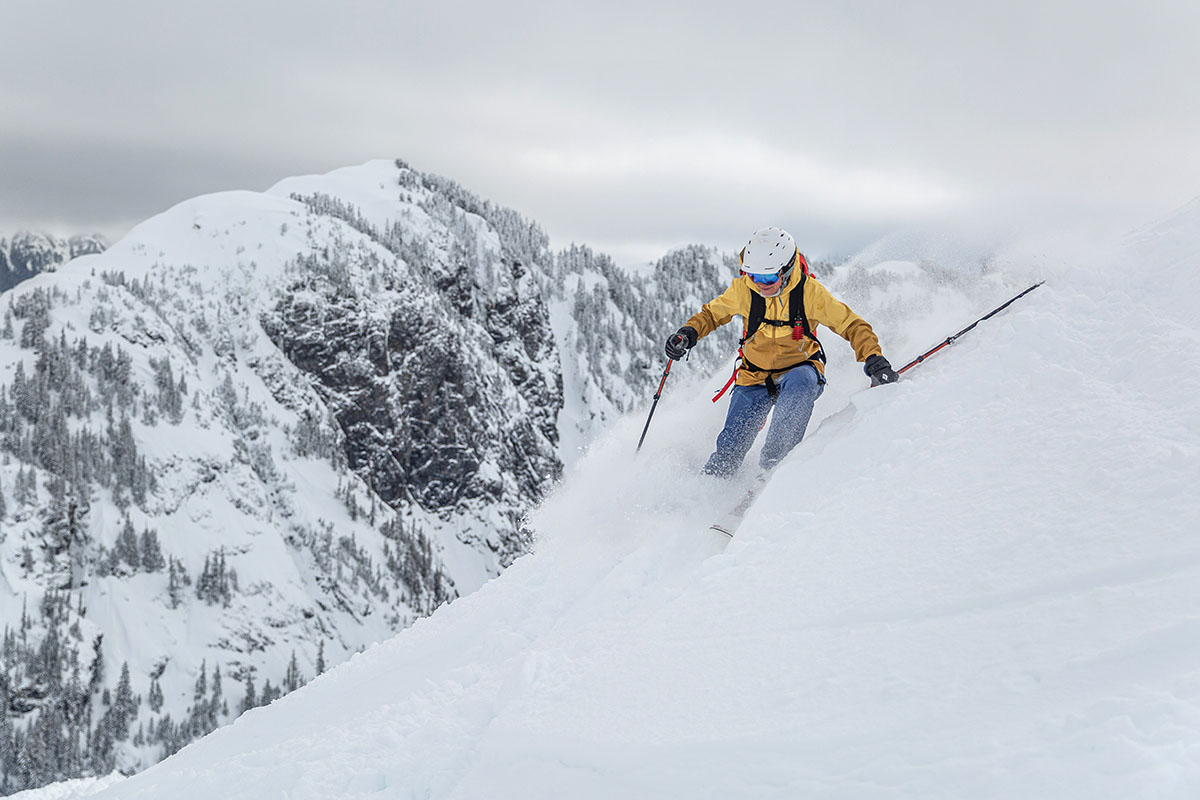
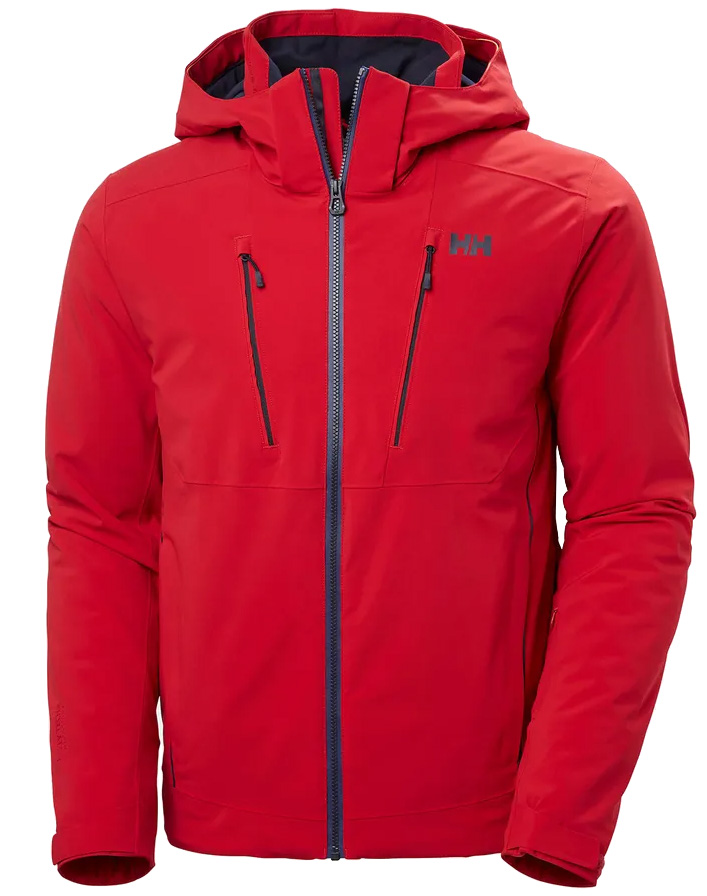 Best for: Resort
Best for: Resort
Type: Insulated (men's: 80g & 60g PrimaLoft Ocean Bound; women's: 100g PrimaLoft Black)
Waterproofing: 2L Helly Tech Professional
What we like: Excellent comfort, dependable protection, and balanced level of warmth for season-long use.
What we don't: Some may prefer a longer cut for added coverage; on the heavier end, even among insulated designs.
For resort skiers who run cold or simply want to streamline the buying process, an insulated ski jacket could be just the ticket. Helly Hansen's Alpha 4.0 and women's-specific Alphelia have been longtime favorites of ours, combining a moderate dose of PrimaLoft insulation in the body and sleeves (note: The men's jacket has a mix of 80g and 60g, while the women's is 100g) with the brand's 2-layer Helly Tech Professonal waterproofing for reliable protection in inclement weather. The net result is a dependable shell that will take the sting out of chilly chairlift rides without overwhelming you on the way down. Unlike some insulated designs, the Alpha and Alphelia are also highly comfortable and easy to move in thanks to the addition of stretch in the fabric. Added up, it's a high-quality and thoughtfully built design that's well tuned for frequent resort use—especially in the depths of winter.
Keep in mind that insulated designs are inherently less versatile than uninsulated jackets. Many people—this author included—like the ability to tweak their layering system depending on the temperatures and conditions, which you can't do with the Alpha or Alphelia. We also came away with a couple of fit and finish complaints in testing: The men's Alpha wasn't quite long enough to fully cover our tester's backside on the chairlift, and the hood wasn't easy to adjust when wearing gloves and offered a little less coverage than we prefer. Finally, the Alpha and Alphelia are both relatively heavy, even when stacked up against exclusively insulated designs (although our tester didn't notice it much on the slopes). But while you can certainly go lighter—and cheaper—in the insulated jacket market, we think Helly Hansen nailed the core details better than most competitors.
Read more: men's Helly Hansen Alpha 4.0 review
See the Men's Helly Hansen Alpha 4.0 See the Women's Helly Hansen Alphelia
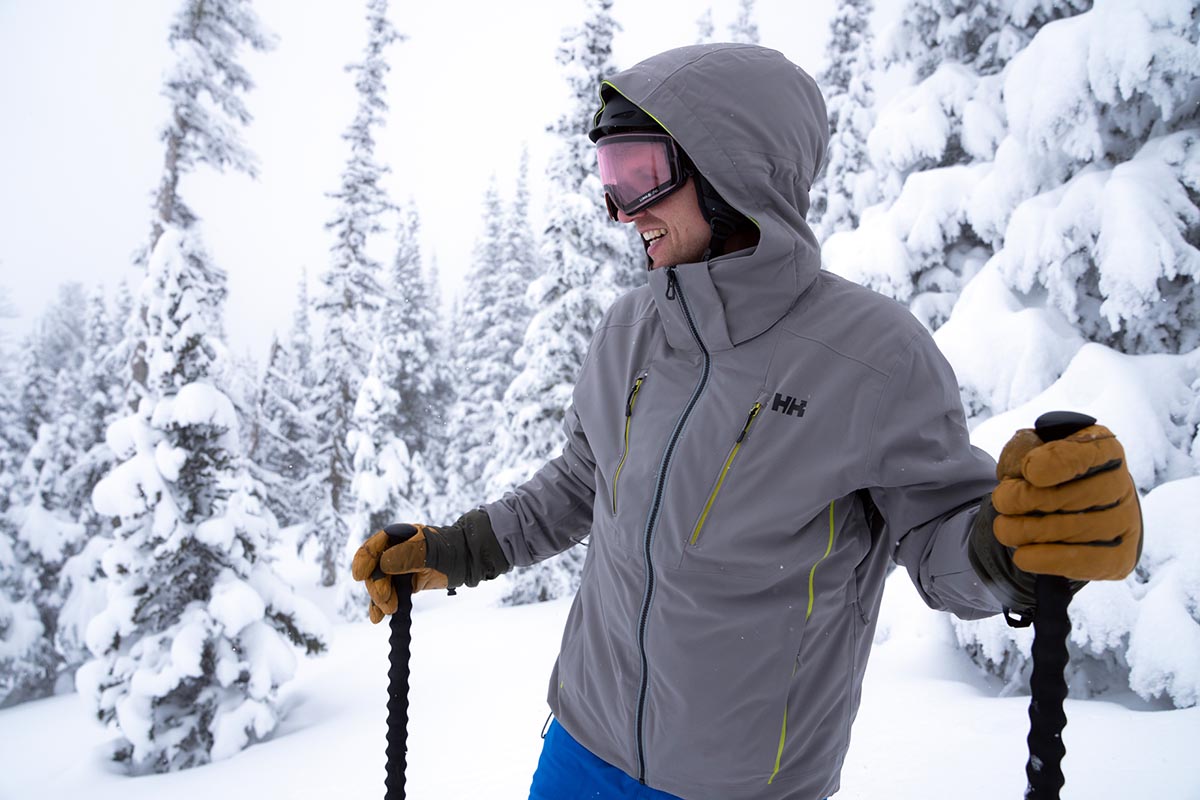
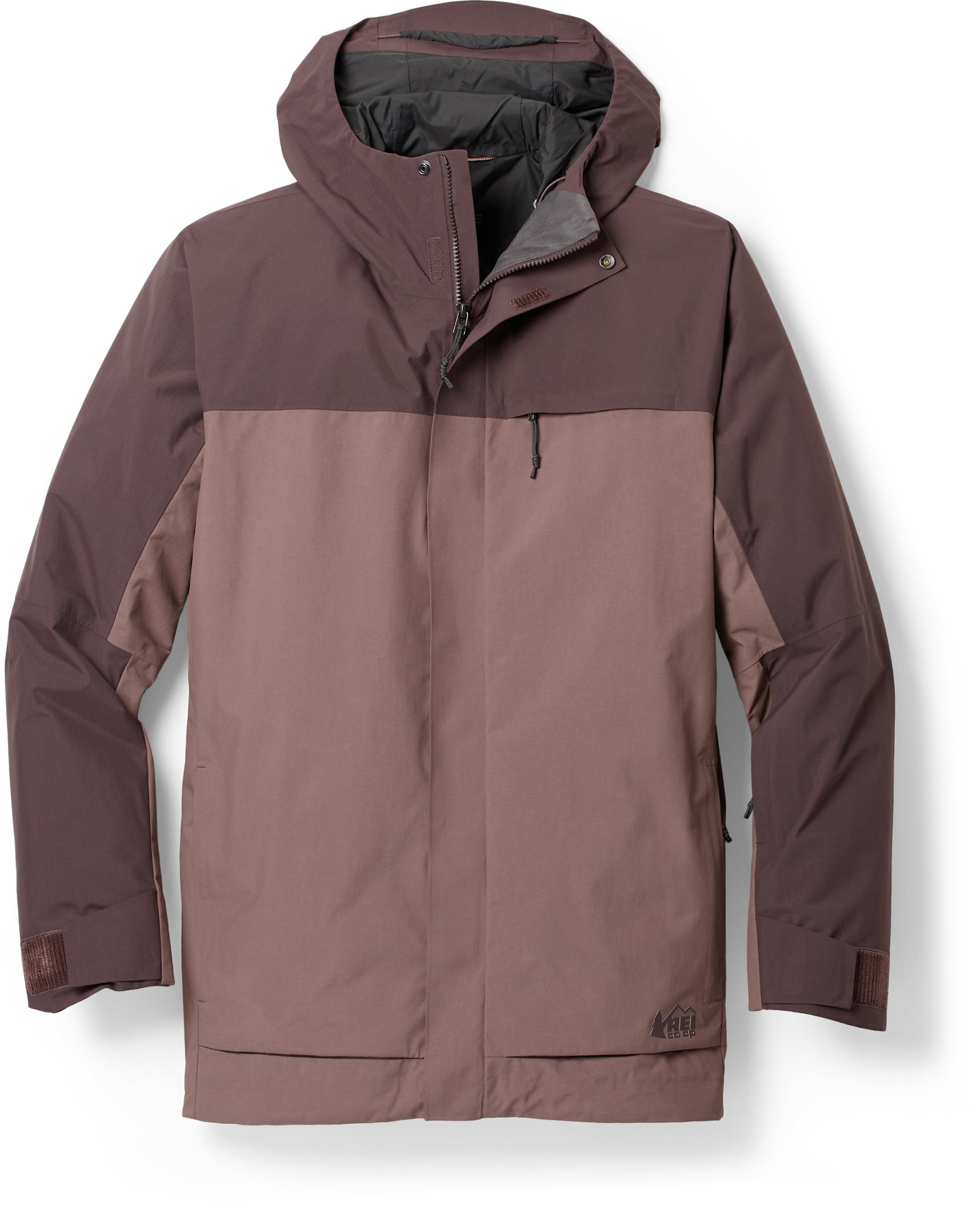 Best for: Resort
Best for: Resort
Type: Insulated (80g & 60g polyester)
Waterproofing: 2L Peak
What we like: Solid resort performance at a hard-to-beat price.
What we don’t: There are some obvious signs of cost-cutting.
We've watched REI Co-op's in-house apparel lineup grow in popularity over the years, and it's easy to see why: Their pieces often undercut the competition significantly while stacking up reasonably well in all-around performance. The Powderbound Insulated Jacket is a case in point: For a very approachable $229, the Powderbound features a waterproof build with a nice dose of insulation (80g around the core and 60g in the sleeves) for keeping you comfortable throughout the winter. All of the requisite features are there, too, including ample organization, a powder skirt, pit zips, and a long cut (33.8 in. for men and 29 in. for women) that provides solid coverage. And while some ski jackets are decidedly flashy in appearance, the Powderbound is relatively subdued and simple, which makes it appealing for wearing casually, too.
We've found REI jackets to be hit or miss when it comes to fit, and in this case, we think the Powderbound could benefit from some improvements. Both of our testers (male and female) found the jacket to be on the larger and boxier end, and the 2-layer construction resulted in a relatively hefty and bulky feel. Additionally, it's important to set reasonable expectations at this price point: The Powderbound's in-house membrane falls short of Gore-Tex in all-out protection, the jacket is only critically seam-sealed, and build quality and comfort are a step down from premium competitors like the Sabre and Alpha above. Still, if value is a selling point for you, the Powderbound is undeniably appealing and outperforms its price tag, in our experience.
See the Men's REI Powderbound See the Women's REI Powderbound
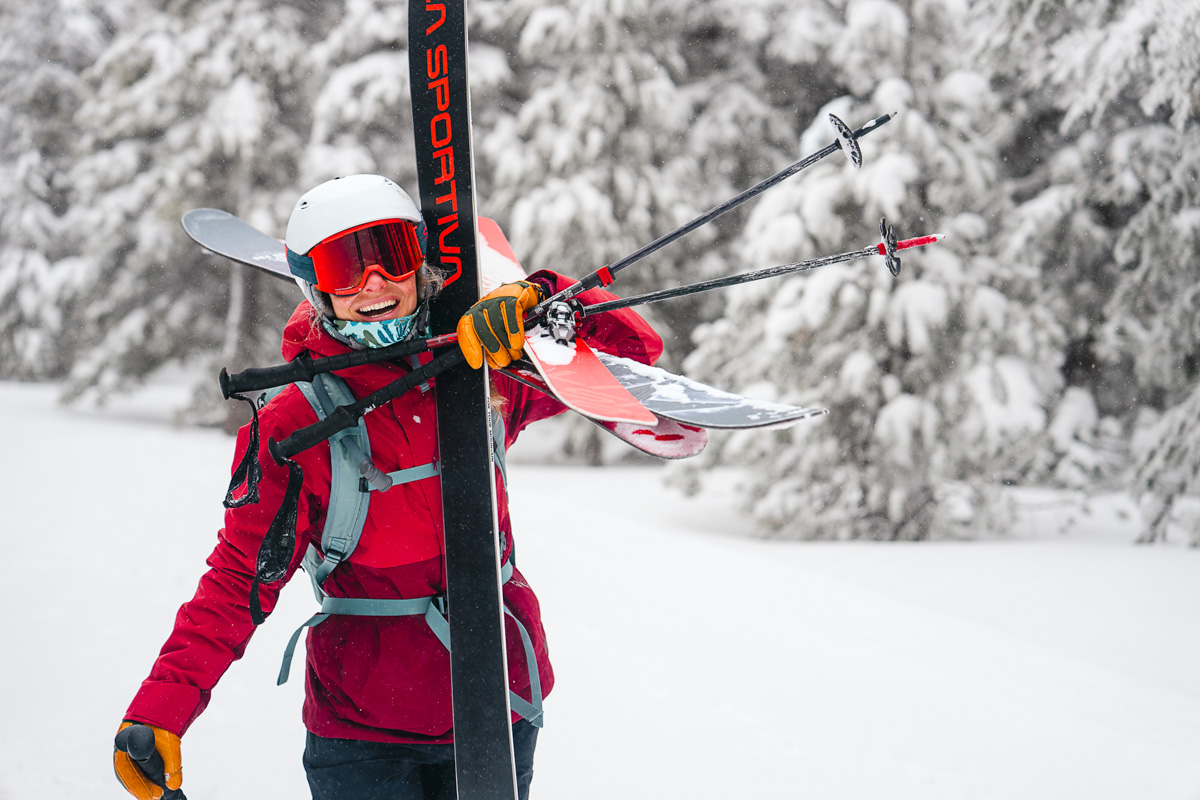
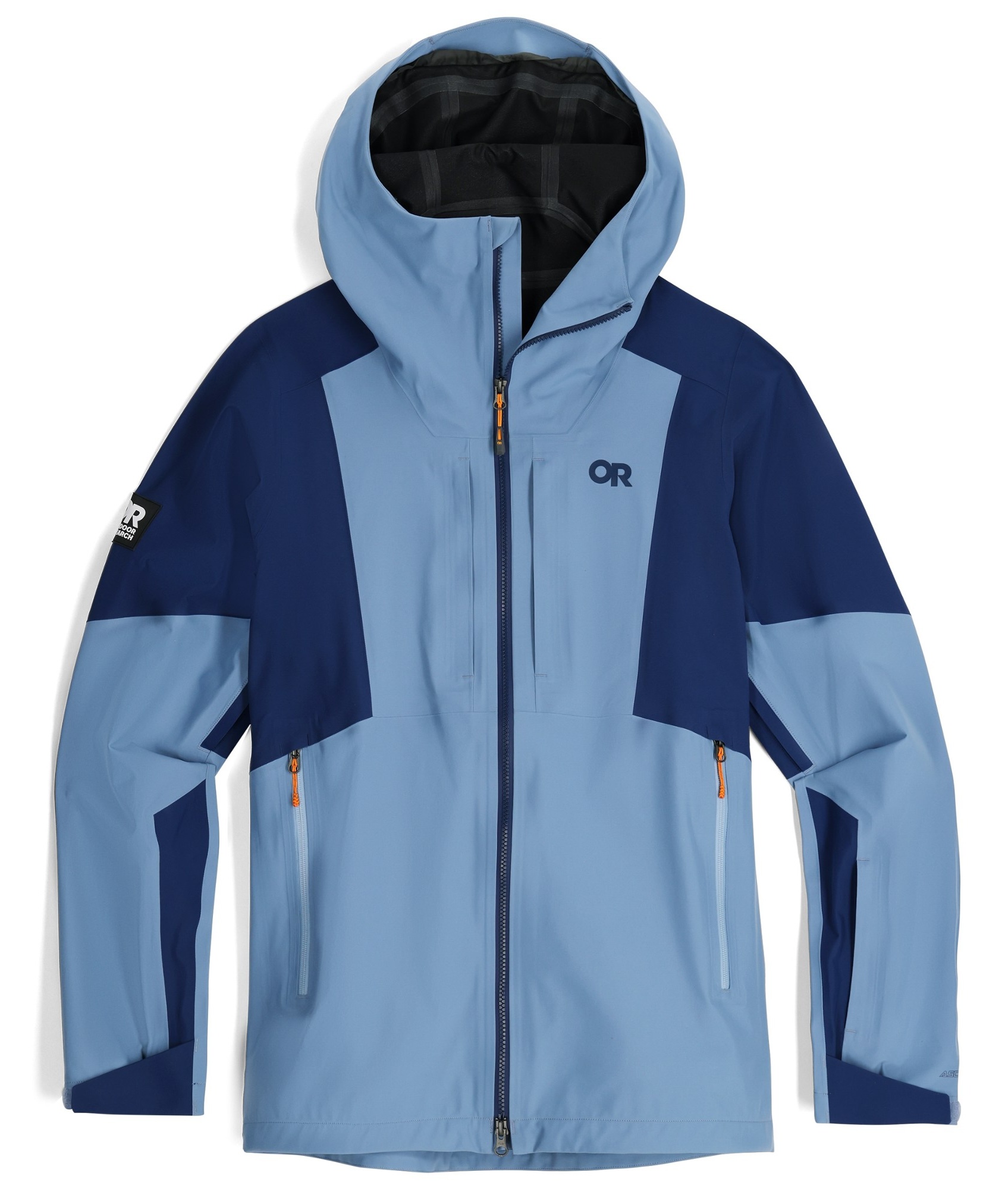 Best for: Backcountry
Best for: Backcountry
Type: Shell
Waterproofing: 3L AscentShell
What we like: Top-notch comfort, ventilation, and mobility for heart-pumping days on the skin track.
What we don’t: Not the most reliable choice in heavy, extended moisture.
Backcountry skiers have a different set of requirements compared to resort riders. Since they spend a lot of their time exerting on the uphill, they often prioritize breathability over all-out protection and try to keep weight and bulk to an absolute minimum. With that in mind, Outdoor Research's Skytour AscentShell Jacket was a shoo-in for our favorite men's backcountry design this year. As its name suggests, the Skytour employs OR's in-house AscentShell membrane, which stretches and breathes like a softshell jacket while still maintaining reliable protection when the skies open up. In fact, our tester praised the Skytour as being one of the most breathable jackets he ever tested—softshells included. The large pit zips certainly help, and we enjoyed how easy it was to move in the jacket due to the stretchy and supple fabrics.
However, there are some notable downsides to opting for such a stretchy and breathable design. Due to the added air permeability in the fabrics, the Skytour isn't a particularly impervious layer. It was a fine match for mostly mild conditions throughout the Lake Tahoe area this past winter, but once we subjected it to a shower test, the exterior was quick to wet out, and we expect moisture would have eventually made its way to the interior. In other words, the Skytour wouldn't be our top choice for areas that see a lot of wet snow (such as the Pacific Northwest). The relatively thin, 40- by 65-denier (D) shell fabric doesn't help, providing a less bombproof barrier than competitors like the 80D Sabre above. But there are always trade-offs to consider, and the Skytour remains hard to beat when it comes to maximizing comfort and ventilation on the skin track.
Read more: men's OR Skytour AscentShell Jacket review
See the Men's Outdoor Research Skytour
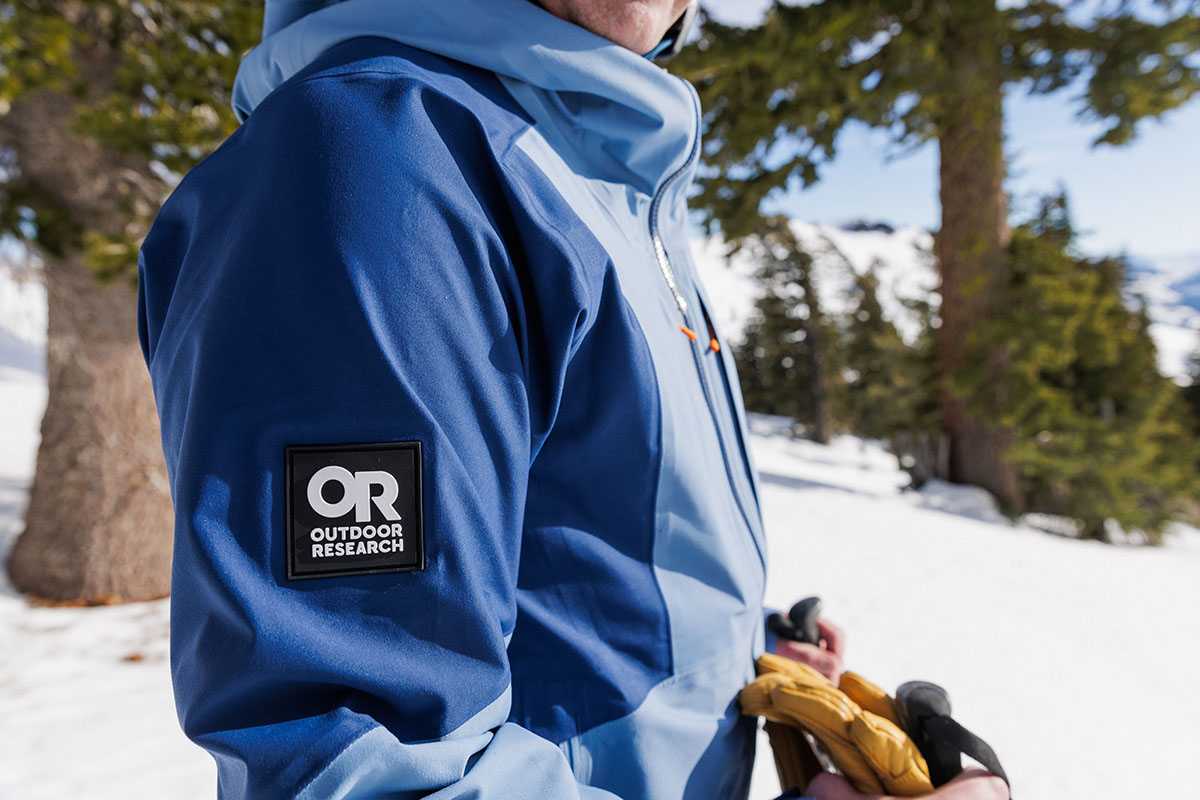
 Best for: Backcountry/resort
Best for: Backcountry/resort
Type: Shell
Waterproofing: 3L H2No Performance Standard
What we like: Stretchy, breathable, lightweight, and built with an eye toward sustainability.
What we don’t: Lacks the impervious feel of similarly equipped Gore-Tex jackets; storage layout could be improved.
Another breathable and stretchy design that we love is Patagonia's SnowDrifter Jacket, which was quick to impress our female tester. Boasting Patagonia's in-house H2No build and a soft knit backer (which the Skytour above lacks), the SnowDrifter is impressively easy to move in and well ventilated for long slogs into the backcountry. We also came away pleased by the feature set, which includes a well-designed hood, six total pockets, an adjustable powder skirt, and two-way pit zips. It's all wrapped up in a competitively lightweight (1 lb. 5.2 oz.) and compressible package that's easy to stash in a ski backpack when not in use. A final feather in the SnowDrifter's cap is its strong sustainability slant, including a fully PFAS-free construction, recycled materials, and certification to the Fair Trade standard.
However, like the Skytour above, the Patagonia SnowDrifter makes some concessions in order to maximize breathability and keep weight and bulk to a minimum. While reliable and protective, the 50D shell fabric lacks the bombproof feel you get with thicker Gore-Tex alternatives like the Sentinel above. There's also no logical spot to stash climbing skins or an AIARE field book, which we consider a questionable omission given the jacket's backcountry focus. And while not a dealbreaker by any means, we found the hood and hem toggles difficult to manipulate with cold or gloved hands. But overall, the SnowDrifter manages its priorities very well, and we think it crosses over better for occasional resort use better than the Skytour above, which helps justify the $20 jump in cost.
Read more: women's Patagonia SnowDrifter Jacket review
See the Women's Patagonia SnowDrfiter Jacket

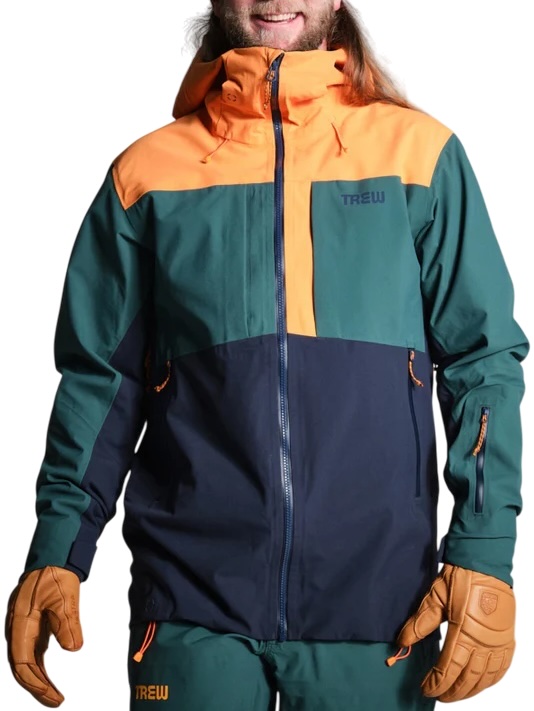 Best for: Resort/backcountry
Best for: Resort/backcountry
Type: Shell
Waterproofing: 3L PNW Primo
What we like: Stalwart protection, built to last, and trendy freeride styling.
What we don’t: Focus on durability and storage limits backcountry appeal.
Oregon-based Trew Gear is a brand on the rise, and their men's Cosmic and women's Stella Primo jackets were especially quick to stand out in our testing. Weather protection is an obvious selling point: Utilizing Trew's in-house PNW Primo membrane, both jackets have a fortress-like feel that's reminiscent of premium Gore-Tex designs, along with a full suite of protective features that make it easy to batten down the hatches. Impressively, Trew managed to accomplish this while maintaining a high level of comfort thanks to built-in stretch, a soft and smooth interior, and a relaxed, freeride-inspired fit. Tack on tons of functional storage (eight pockets on the men's jacket and seven on the women's), quality fabrics and components that hold up well over time, and a nice selection of sizes and fun colorways, and the Cosmic and Stella stand out as impressively capable and well-rounded options for resort use, sidecountry hikes, and short trips into the backcountry.
However, Trew Gear clearly prioritized storage and durability over keeping things light, and the resulting heft and bulk aren’t ideal for frequent backcountry use. Additionally, we found both the Cosmic and Stella to be lacking in breathability for high-output tours, although the pit zips get the job done on sidecountry adventures and short bootpacks (note: The pit zips on the Stella are 4 in. shorter than those on the Cosmic). And while largely subjective, some may not love the styling, which is flashier than what you get with the sleek Sabre/Sentinel above (we're personally big fans). Complaints aside, the Cosmic and Stella jackets are tough, protective, and feature-rich, earning them high marks overall.
Read more: men's Cosmic Primo review and women's Stella Primo review
See the Men's Trew Gear Cosmic Primo See the Women's Trew Gear Stella Primo
 Best for: Resort
Best for: Resort
Type: Shell (fleece liner)
Waterproofing: 2L Gore-Tex ePE
What we like: Proven Gore-Tex waterproofing, soft interior, and beefy construction for aggressive resort riding.
What we don’t: Pricey for a 2-layer design and not a weight leader.
Joining Patagonia's SnowDrifter above is their resort-focused Storm Shift, which is one of the most premium resort designs here. Rather than an in-house construction, Patagonia opted for a proven, 2-layer Gore-Tex ePE membrane that kept us bone-dry in wet and rowdy Pacific Northwest conditions. The 150D shell fabric contributes to the bombproof feel and has deftly withstood frequent use and abuse, and we're big fans of the thin fleece lining, which adds a nice boost in warmth and comfort for cold resort days without detracting too heavily from breathability. And like the SnowDrifter above, the Storm Shift is an easy jacket to get behind thanks to its clear focus on sustainability.
What's not to like with the Patagonia Storm Shift Jacket? The biggest drawbacks are price and weight: At $499, the Storm Shift is expensive for a 2-layer design, and both the men's and women's styles are on the hefty end for uninsulated shells. We also wish Patagonia had positioned the interior and exterior chest pockets on different sides, as the current configuration leads to a good amount of bulk when both pockets are in use. But if you're willing to pay the price, we think the Storm Shift is a worthy investment: It's reliably protective, clearly built to last, and checks all the boxes for committed resort-goers in a clean and sustainably minded package.
Read more: men's Patagonia Storm Shift review
See the Men's Patagonia Storm Shift See the Women's Patagonia Storm Shift
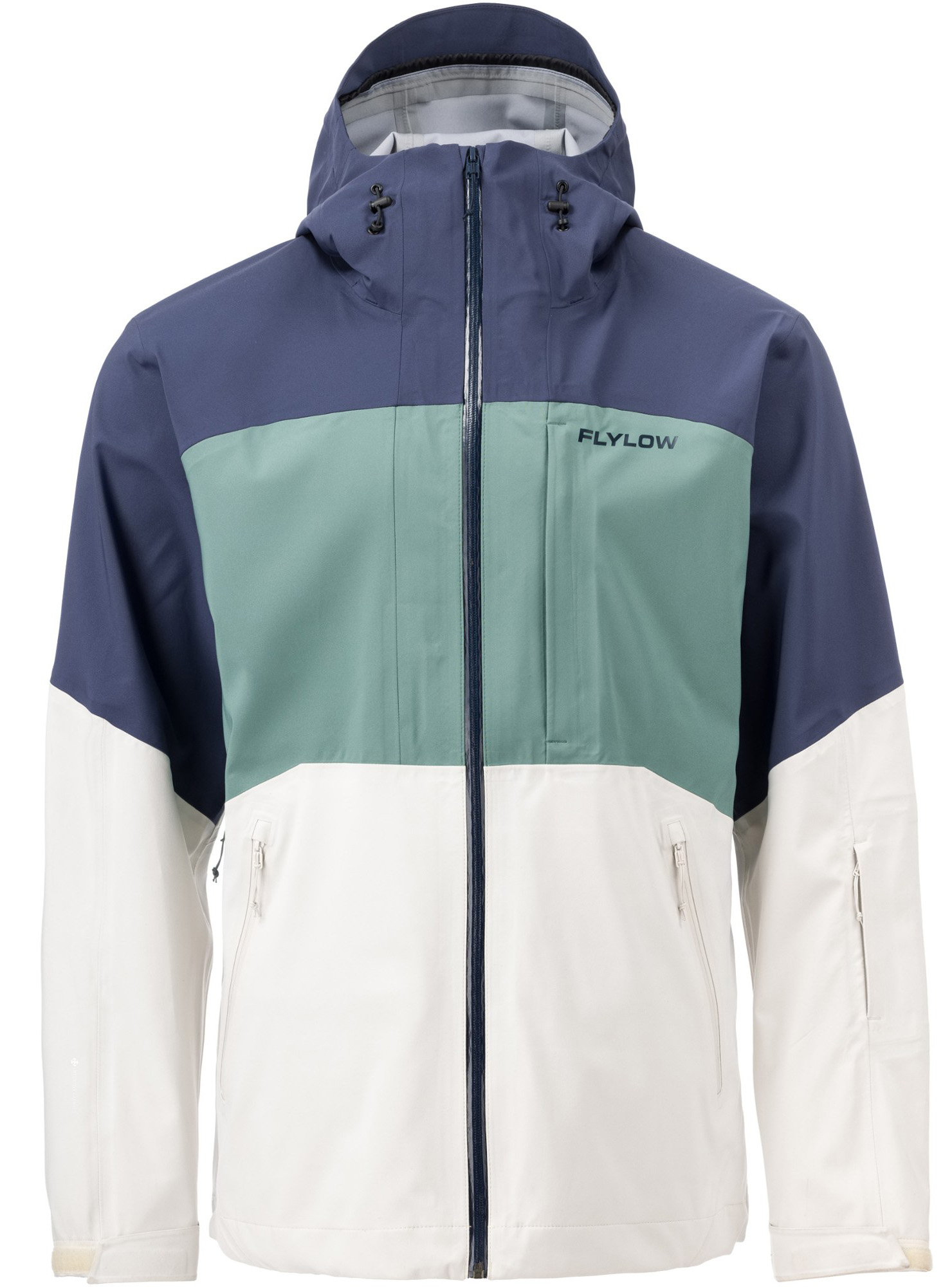 Best for: Backcountry/resort
Best for: Backcountry/resort
Type: Shell
Waterproofing: 3L Tactic
What we like: Stretchy and breathable like a softshell with dependable 3-layer protection.
What we don’t: Non-stretchy designs are the better choice for truly wet conditions; no place to stash climbing skins.
Like Trew Gear, Flylow Gear flies a little under the radar compared to big names like Arc'teryx and Patagonia, but we've been highly impressed with several of their pieces over the years. One longtime favorite is the men's Malone and women's Lucy, which Flylow lists as a softshell jacket. That doesn't do the design justice, though: Flylow's Tactic construction is full-on hardshell, complete with the dependable protection that we expect from 3-layer designs. The jacket also comes fully seam taped and features a host of weather-ready features, including a removable powder skirt, a helmet-compatible hood, adjustable cuffs, and YKK waterproof zippers. Added up, the Malone and Lucy combine the best attributes of both softshell and hardshell jackets, including standout comfort, great mobility, and dependable coverage when the weather turns.
However, as we saw with the OR Skytour and Patagonia SnowDrifter above, stretchy and breathable designs typically lack the bombproof feel you get from Gore-Tex competitors. That holds true for the Malone and Lucy, which we found to be a great match for riding in the Rocky Mountains but not as well suited for notoriously wet areas like the Pacific Northwest. And given the jacket's backcountry slant, we wish it came with internal dump pockets for stashing climbing skins (note: The men's jacket has a single dump pocket for storing a beanie or gloves, while the women's omits them entirely). Some will also prefer a trimmer fit, although we never felt restricted during testing (the soft and stretchy fabrics help a lot). Gripes aside, the Malone and Lucy strike a really enticing balance for mixed resort and backcountry riding, and we can't help but love the great-looking design—especially in the tri-color patterns.
Read more: women's Flylow Gear Lucy review (prior version)
See the Men's Flylow Gear Malone See the Women's Flylow Gear Lucy
 Best for: Resort
Best for: Resort
Type: Insulated (80g & 40g Thermogreen)
Waterproofing: 2L H2No
What we like: Another cozy and well-built option for resort riders; cheaper than the Alpha 4.0 above.
What we don’t: A couple small fit and finish issues.
Joining the Helly Hansen Alpha 4.0 above is another premium insulated design to have on your radar: Patagonia's Insulated Powder Town Jacket. Like the Alpha, the Powder Town features 80g synthetic throughout the body for a healthy—but not overwhelming—dose of cozy warmth. We also came away impressed by the 2-layer H2No membrane, which did an admirable job sealing out gnarly winter weather on Mount Washington and in British Columbia's Manning Park. As we've come to expect from Patagonia, there's no shortage of thoughtful touches, from the drop-in interior pocket for stashing ski goggles to a soft-touch taffeta lining that feels great and slides smoothly over baselayers. It's not particularly cheap for an entry-level design at $399, but we've found that Patagonia gear is almost always worth the upcharge for the level of quality and performance.
The Insulated Powder Town Jacket is an undeniably cozy and well-built option for resort riders (especially those who run cold). We did find it to be lacking in breathability for anything more than short sidecountry jaunts, but that's not too surprising given the 2-layer build and emphasis on warmth. A couple other small annoyances surfaced in testing, including irritation along our jawline from rubbing against the collar (there's a thin layer of fleece, but it's not enough) and front hood drawcords that are difficult to use when wearing gloves. But realistically, these are very minor complaints and did little to dampen our enthusiasm for the jacket. Note: The entire Powder Town collection is discounted at the time of publishing, and we’ve reached out to Patagonia to confirm that the line will be continued for next season. In the meantime, it’s a great opportunity to score a very well-built jacket at a hard-to-beat price.
Read more: women's Insulated Powder Town review
See the Men's Insulated Powder Town See the Women's Insulated Powder Town
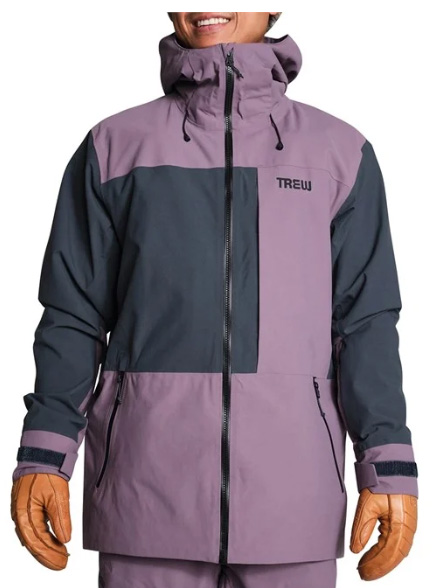 Best for: Resort
Best for: Resort
Type: Shell
Waterproofing: 2L PNW
What we like: Checks all the boxes for casual resort-goers at a competitive price.
What we don’t: Relatively heavy, bulky, and lacking in breathability.
Trew Gear's Cosmic Primo above is an attractive 3-layer design, but their 2-layer men's Jefferson and women's Astoria will save you a good chunk of change. For a very reasonable $329, the design checks most of the boxes we look for in a well-rounded resort shell: It's reliably protective with a quality in-house membrane and full suite of weather-ready features, built with thick and hardwearing fabrics, and boasts excellent coverage for deep powder days and cold chairlift rides. Like the Cosmic and Stella featured above, the Jefferson and Astoria also have a relaxed fit that makes it easy to layer underneath and lends a stylish freeride aesthetic (although it did prove a bit restrictive for us when bending over to adjust boots and bindings).
In parsing out the differences between the Jefferson and Astoria, the Jefferson has a slightly longer cut (by 1.5 in.), weighs 2 ounces more, and omits fabric flaps over the hand pockets. We didn't like these flaps when testing the women's model: They add a good amount of bulk and make it difficult to access the hand pockets, often requiring us to use one hand to hold the jacket in place along the bottom hem while using the other to operate the pocket zipper. Both styles are heavy given their uninsulated builds, relatively bulky in look and feel, and not particularly breathable. Still, the Jefferson and Astoria are a solid value considering the level of protection and durability, and we're suckers for Trew Gear's distinctive styling.
Read more: women's Trew Gear Astoria review
See the Men's Trew Gear Jefferson See the Women's Trew Gear Astoria
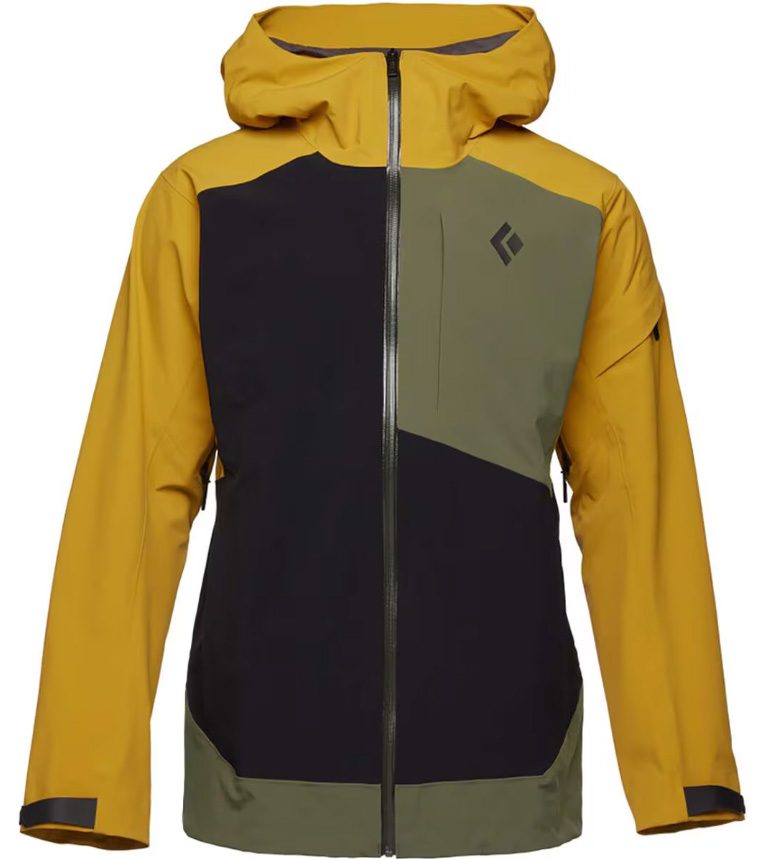 Best for: Resort/backcountry
Best for: Resort/backcountry
Type: Shell
Waterproofing: 3L BD.dry
What we like: Well-rounded performance for both resort and backcountry use.
What we don't: Heavier and bulkier-feeling than the OR Skytour above; not our favorite fit.
Black Diamond is a relative newcomer to the world of ski apparel, but they've wasted no time in assembling a quality lineup of resort- and backcountry-ready shells. The Recon Stretch toes the line nicely, offering well-rounded performance for both inside and outside the ropes. Like many other backcountry-ready designs here, the Recon features a 3-layer construction (BD's in-house tech) with integrated stretch. The net result is strong weather protection alongside great comfort and mobility. On the uphill, we appreciate features like the powder skirt and internal mesh drop pockets for stashing skins, while features like a lift pass pocket on the left arm and a ski helmet-compatible hood add convenience on resort days.
However, while the Black Diamond Recon Stretch is a nice all-rounder, it falls short of the Outdoor Research Skytour above in a few ways. For starters, it's 5 ounces heavier and feels that way on the slopes, especially during mobility-dependent activities like hikes into the sidecountry. Our male tester wasn't the biggest fan of the fit, either, with the long cut leading to awkward bunching around the hem. A final knock is price, although the Recon isn't that far off from competitors like the Flylow Malone ($400) and OR Skytour ($429) above. All told, it's a competitively well-rounded design that's worth having on your radar, whether you prefer to take the lift, earn your turns, or mix it up depending on the conditions.
See the Men's BD Recon Stretch See the Women's BD Recon Stretch
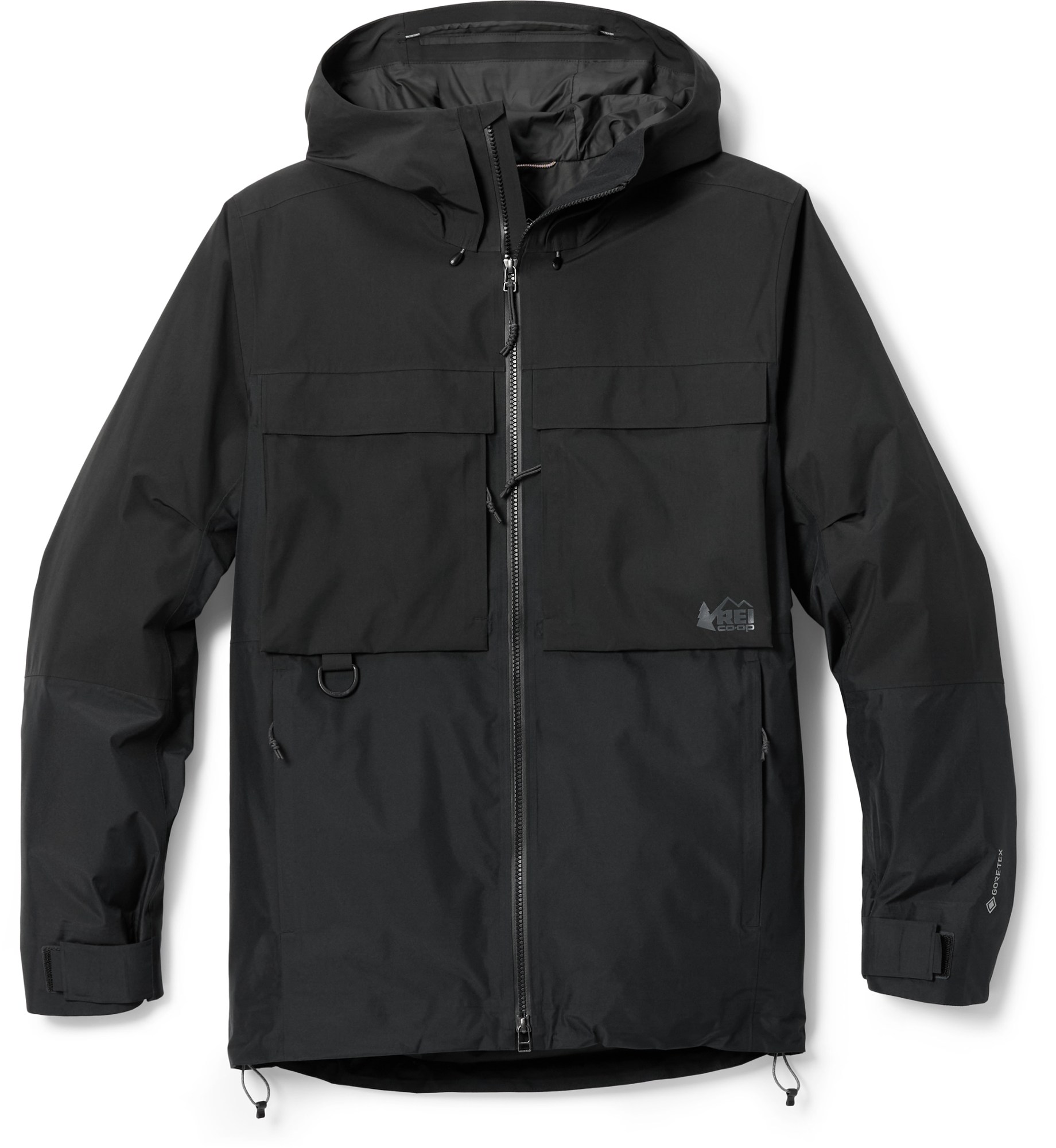 Best for: Resort
Best for: Resort
Type: Shell
Waterproofing: 2L Gore-Tex ePE
What we like: The cheapest Gore-Tex design on our list.
What we don’t: We found wind resistance to be a little lacking; not particularly light, packable, or breathable.
REI's Powderbound above is our favorite budget design for men and women, but not everyone wants—or needs—an insulated ski jacket. Enter their First Chair GTX, which is a step up price-wise at $319 but comes with a host of upgrades. First is the Gore-Tex ePE membrane, which is a much more reliable performer than their in-house tech when it comes to sealing out the elements. This makes the First Chair the cheapest Gore-Tex-equipped jacket to make our list this season, which is no small feat. Importantly, REI paid similar attention to the rest of the design: You get a whopping nine pockets for storage, plenty of protective features for sealing out the elements, a generous fit that's layering-friendly but not overly bulky (plus dedicated tall and plus sizes), and a clear emphasis on sustainability.
While high on value, however, the REI First Chair does come with some noteworthy performance drawbacks. Like most 2-layer designs, the jacket isn't particularly light or packable, and breathability is sacrificed as a result of the hanging liner (compared to more premium 3L shells, which feature an integrated liner). Further, while water resistance is solid, we found the First Chair to be relatively drafty—our tester was able to feel cold gusts through the shell on windy days and when skiing downhill. But we keep coming back to price: The First Chair costs a significant $180 less than the similarly built Storm Shift above. Sure, it isn't as premium or hardwearing, but we certainly understand if the cost savings are worth the drop in quality and windy-weather performance to you.
Read more: men's REI First Chair GTX review
See the Men's REI First Chair GTX See the Women's First Chair GTX
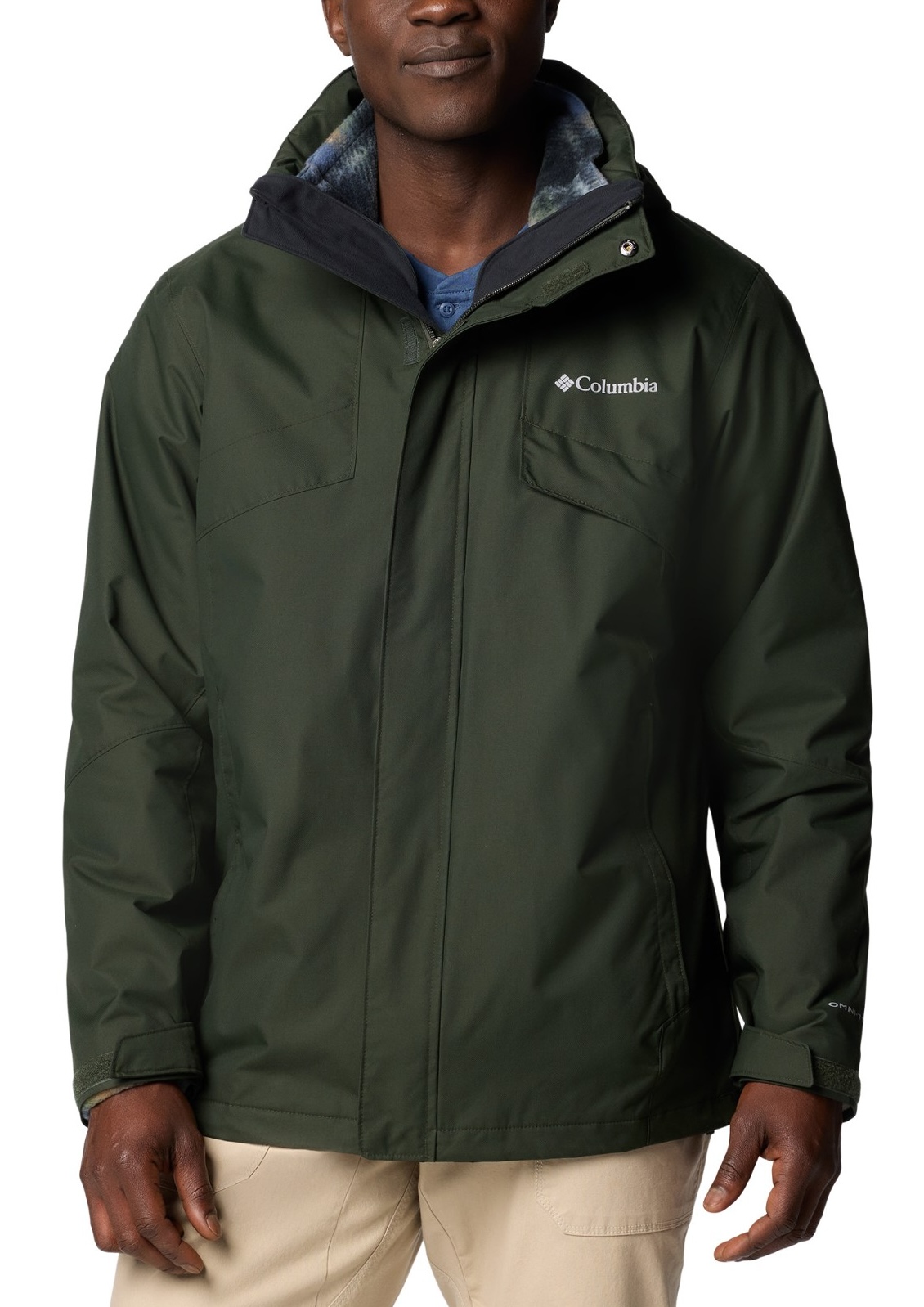 Best for: Resort
Best for: Resort
Type: 3-in-1 (fleece)
Waterproofing: 2L Omni-Tech
What we like: The cheapest ski jacket on our list (and you get two in one).
What we don’t: Performance and build quality line up with the price.
The final ski jacket to make our list this season is also the cheapest: Columbia's Bugaboo III Fleece Interchange Jacket. The Bugaboo is a 3-in-1 design that pairs a fleece zip-out jacket with an in-house Omni-Tech shell for fending off precipitation and wind. The silver lining (dubbed Omni-Heat) is pretty polarizing—it gives off definite disco vibes—but has proven to be pretty effective at trapping body heat and keeping us comfortable. You also get handy features like a removable hood, adjustable cuffs that fit over or underneath gloves, and a drawcord for sealing out drafts and snow at the waist.
However, just as the "you get what you pay for" adage applies to expensive pieces like the top-ranked Arc'teryx Sabre, it's also true of budget designs like the Bugaboo III Fleece Interchange. While perfectly serviceable for mellow resort days on either coast, material quality is a noticeable step down, and it even falls short of the similarly priced REI Powderbound (although the latter isn't a 3-in-1 jacket). Additionally, it's no surprise that the basic shell and lining impact breathability, and there are no pit zips for dumping excess heat (which you get with the Powderbound). But for weekend warriors who get out in mostly favorable conditions, the Bugaboo is a fine choice that won't break the bank. For a similar 3-in-1 design that trades the fleece liner of the Bugaboo for a synthetic jacket, check out the $230 Whirlibird V Interchange.
See the Men's Columbia Bugaboo III See the Women's Columbia Bugaboo III
| Jacket | Price | Best For | Type | Insulation | Waterproof | Weight |
|---|---|---|---|---|---|---|
| Arc’teryx Sabre Jacket | $750 | Resort/backcountry | Shell | None | 3L Gore-Tex ePE | 1 lb. 8.9 oz. |
| Helly Hansen Alpha 4.0 | $475 | Resort | Insulated | 80g / 60g | 2L Helly Tech | 2 lb. 7.5 oz. |
| REI Co-op Powderbound | $229 | Resort | Insulated | 80g / 60g | 2L Peak | 1 lb. 13.0 oz. |
| Outdoor Research Skytour | $429 | Backcountry | Shell | None | 3L AscentShell | 1 lb. 6.1 oz. |
| Trew Gear Cosmic Primo | $499 | Resort/backcountry | Shell | None | 3L PNW Primo | 1 lb. 14.1 oz. |
| Patagonia Storm Shift | $499 | Resort | Shell | None | 2L Gore-Tex ePE | 1 lb. 12.8 oz. |
| Flylow Gear Malone | $400 | Backcountry/resort | Shell | None | 3L Tactic | 1 lb. 8.0 oz. |
| Patagonia Powder Town | $399 | Resort | Insulated | 80g / 40g | 2L H2No | 1 lb. 14.7 oz. |
| Trew Gear Jefferson Jacket | $329 | Resort | Shell | None | 2L PNW | 1 lb. 14.0 oz. |
| Black Diamond Recon | $450 | Resort/backcountry | Shell | None | 3L BD.dry | 1 lb. 11.1 oz. |
| REI First Chair GTX | $319 | Resort | Shell | None | 2L Gore-Tex ePE | 1 lb. 11.7 oz. |
| Columbia Bugaboo III | $210 | Resort | 3-in-1 | Fleece | 2L Omni-Tech | 2 lb. 6.0 oz. |
| Jacket | Price | Best For | Type | Insulation | Waterproof | Weight |
|---|---|---|---|---|---|---|
| Arc'teryx Sentinel Jacket | $750 | Resort/backcountry | Shell | None | 3L Gore-Tex ePE | 1 lb. 5.3 oz. |
| Helly Hansen Alphelia | $475 | Resort | Insulated | 100g | 2L Helly Tech | 2 lb. 3.3 oz. |
| REI Powderbound Insulated | $229 | Resort | Insulated | 80g / 60g | 2L Peak | 1 lb. 10.1 oz. |
| Patagonia SnowDrifter | $449 | Backcountry/resort | Shell | None | 3L H2No | 1 lb. 5.2 oz. |
| Trew Gear Stella Primo | $499 | Resort/backcountry | Shell | None | 3L PNW Primo | 1 lb. 13.5 oz. |
| Patagonia Storm Shift | $499 | Resort | Shell | None | 2L Gore-Tex ePE | 1 lb. 9.5 oz. |
| Flylow Gear Lucy | $400 | Backcountry/resort | Shell | None | 3L Tactic | 1 lb. 5.6 oz. |
| Patagonia Powder Town | $399 | Resort | Insulated | 80g / 40g | 2L H2No | 1 lb. 10.9 oz. |
| Trew Gear Astoria Jacket | $329 | Resort | Shell | None | 2L PNW | 1 lb. 12.0 oz. |
| Black Diamond Recon | $450 | Resort/backcountry | Shell | None | 3L BD.dry | 1 lb. 7.5 oz. |
| REI First Chair GTX | $319 | Resort | Shell | None | 2L Gore-Tex ePE | 1 lb. 8.0 oz. |
| Columbia Bugaboo III | $210 | Resort | 3-in-1 | Fleece | 2L Omni-Tech | Unavail. |
Winter means snow in most parts of the U.S., and as a result, many staff members at Switchback Travel spend a lot of time on the slopes. Former editor-in-chief and lifelong skier John Ellings put together our initial list of seven jackets in 2015, drawing from years of experience throughout the Pacific Northwest. Longtime contributors Brian McCurdy and Sasha Brown were also critical in putting together our backcountry picks. Based in British Columbia, Brian and Sasha are no strangers to epic powder days and long missions into the backcountry. Editor Maddie Downie, a longtime Washington resident and skier, began contributing to the guide in early 2024. Maddie has toured all over the North Cascades and knows what it takes to weather a wet PNW winter. Finally, managing editor Sarah Nelson helped hone the list in early 2025, incorporating several women's styles to align with the guide's unisex focus.
Our current lineup of 14 jackets reflects our ongoing testing experiences, firsthand info from testers and gear-savvy friends, and feedback from the online skiing community. When we test ski jackets, we look closely at factors like waterproofing, breathability, and durability, including paying attention to how well each jacket holds up over time. We also evaluate features like hoods, pockets, and powder skirts for overall functionality and ease of use. Finally, we recognize that the ski jacket market isn’t static. As a result, we will continue to test new and noteworthy designs as they become available, adding any standouts to the list above. For a wider look at the market, we've also put together round-ups of the best men's ski jackets and best women's ski jackets.
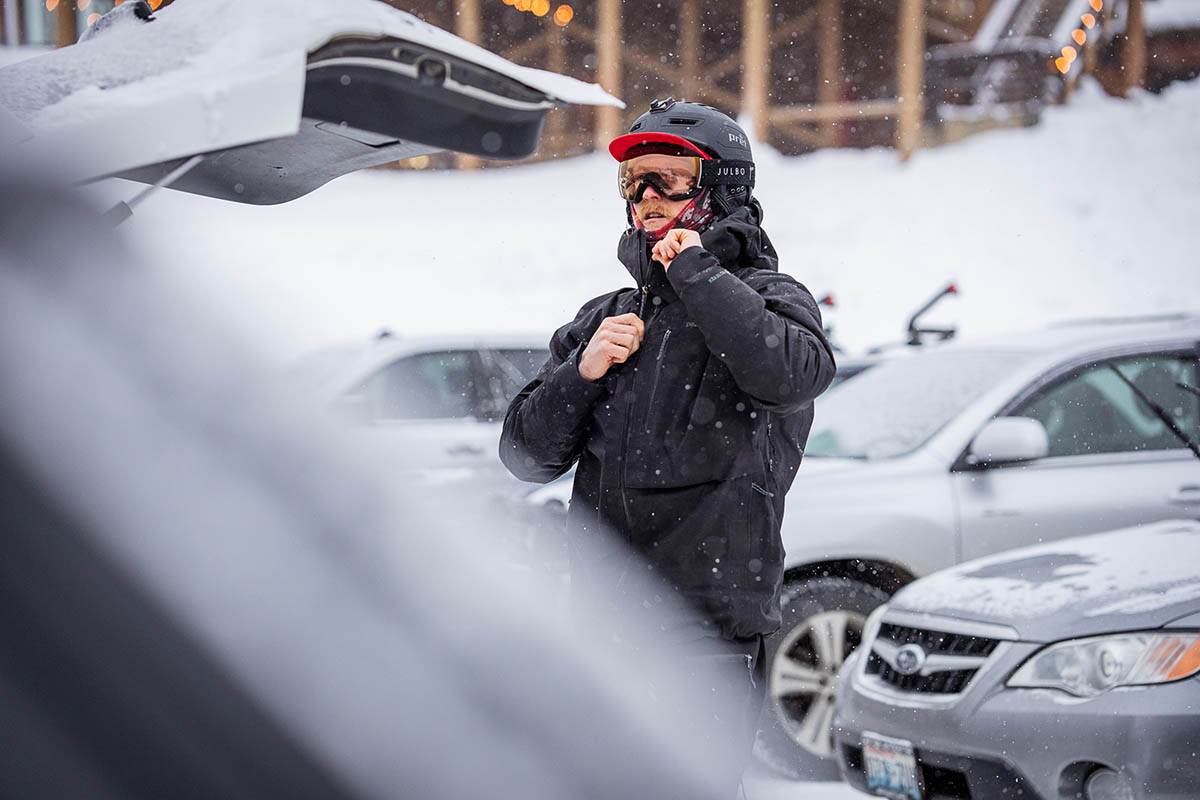
Ski jackets are often designed with a specific purpose in mind—whether for resort skiing, backcountry adventures, or a combination of both. To help guide your selection, we’ve included a "best for" listing in the specifications and comparison tables above. Since most riders spend at least some time on chairlifts during the season, the majority of ski jackets are designed to withstand the rigors of resort use. Specifically, resort jackets should be highly wind- and waterproof, durable, and include conveniences like practical storage, a powder skirt, and a layering-friendly fit that allows you to tweak your baselayers and midlayers depending on conditions. Insulation is optional for resort skiers and generally not recommended for backcountry-goers.
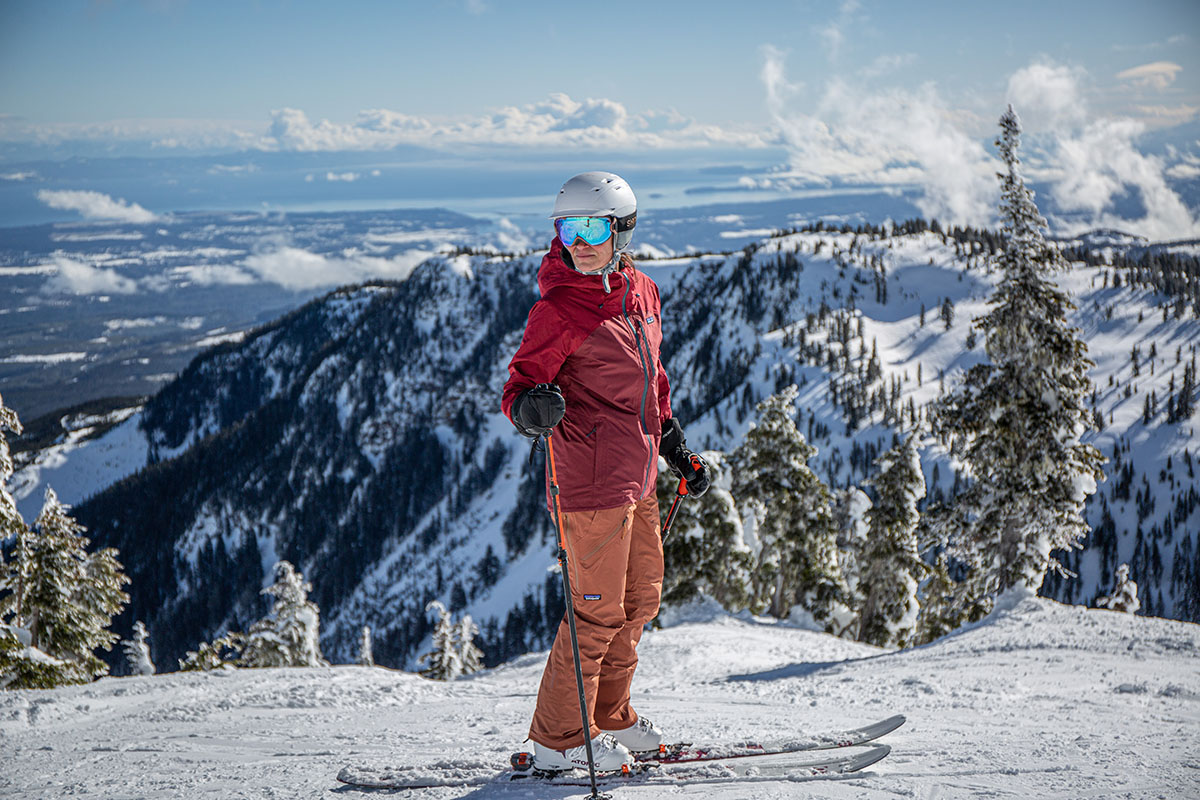
For ski touring, ski mountaineering, or sidecountry excursions, a lightweight, non-insulated jacket is preferable. Fabrics are typically thinner, prioritizing breathability, mobility, and packability, although these often come at the sacrifice of durability. Softshell jackets lead the pack in breathability and comfort, making them great for fair-weather days, but a premium hardshell is still best in heavy wind and moisture (we dive deeper into the various constructions below. Fit does differ depending on intended use: Freeride-oriented shells are looser, while touring-specific models have a more athletic cut. Jackets that cross over well between resort and backcountry use—including the top-rated Arc’teryx Sabre and women's Sentinel—have an excellent fit, solid construction, and fabrics that effectively balance weather protection and breathability.
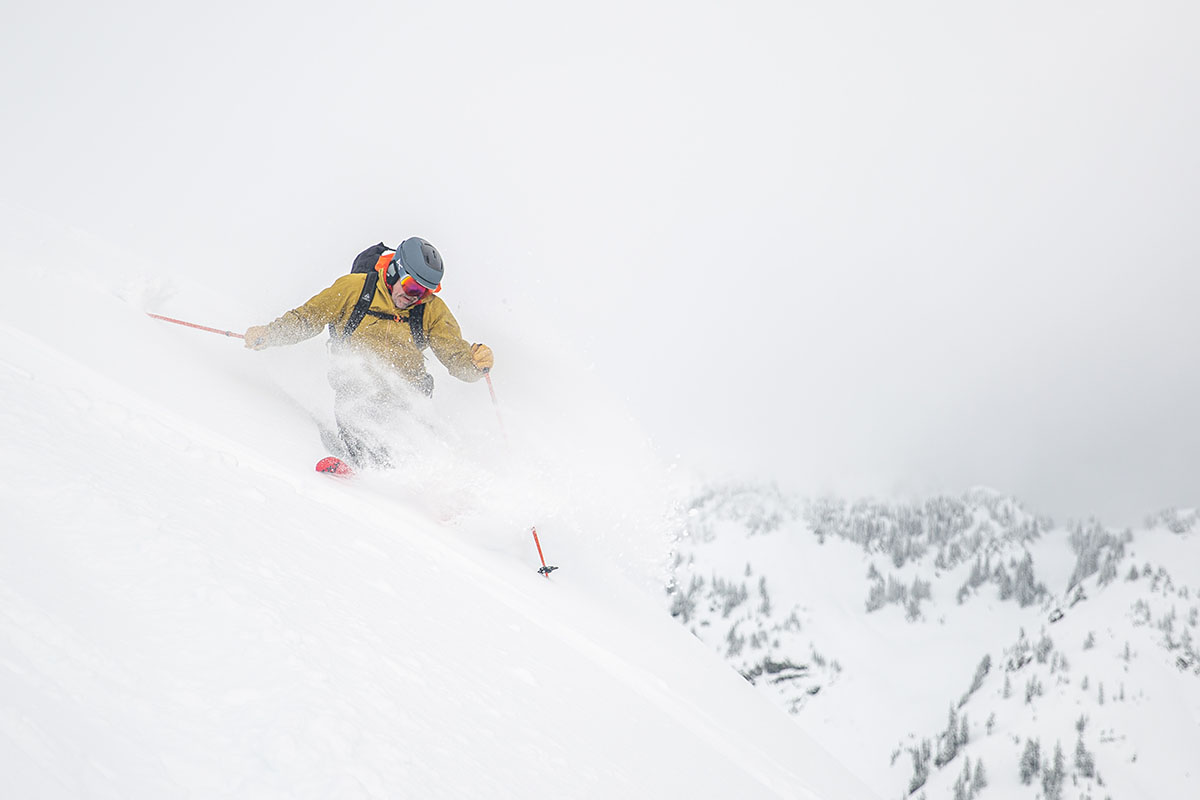
A ski jacket’s construction type is closely linked to its intended use, and the market can generally be divided into three main categories: shell, insulated, and 3-in-1 jackets. Your choice will largely depend on your riding style and budget. Hardshells are the most popular option, offering versatility for everyone from casual resort skiers to backcountry riders in harsh, wet environments. Softshell jackets are more flexible and comfortable than hardshells, though they offer limited protection against wind and moisture. Insulated jackets are ideal for resort skiing in deep winter or in regions with consistently cold temperatures, while 3-in-1 jackets are a nice choice for budget-conscious skiers or those just starting to build their kit. Below is a quick summary of each type. For more info on the topic, check out our article on ski jacket types.
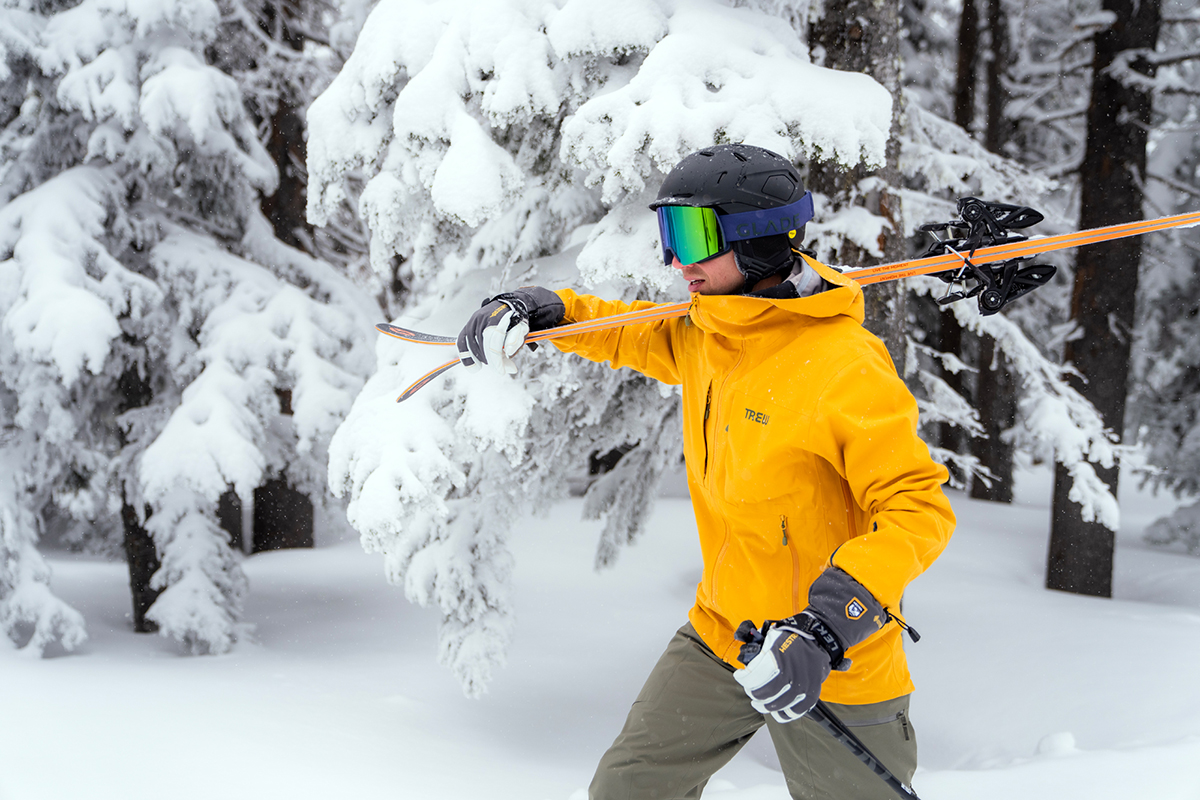
Shell (Non-Insulated) Jackets
Shell jackets are built to provide solid protection against wind and moisture, making them suitable for both resort and backcountry use. They are typically made with multiple layers of fabric laminated together, offering reliable waterproofing, windproofing, and at least modest levels of breathability. These jackets are not insulated, so you'll need to pair them with a baselayer (and usually a midlayer, as well) for warmth.
Premium shell jackets like the Arc’teryx Sabre/Sentinel feature high-end waterproof/breathable membranes (like Gore-Tex, Patagonia’s H2No, and Outdoor Research’s AscentShell) and tailored fits that allow for excellent freedom of movement. Some shells boast stiff and rigid materials, while many backcountry-ready offerings integrate stretch or panels of softshell, which offer great mobility and breathability but fall a bit short in all-out protection (for more, see our breakdown of hybrid hard/softshells below). Entry-level shells often use thicker fabrics and cheaper waterproof membranes that don’t allow for much airflow. Beginners and infrequent riders can get by with one of these more affordable models, but for active and aggressive skiers who spend a lot of time on the slopes, it’s a good idea to spend up.
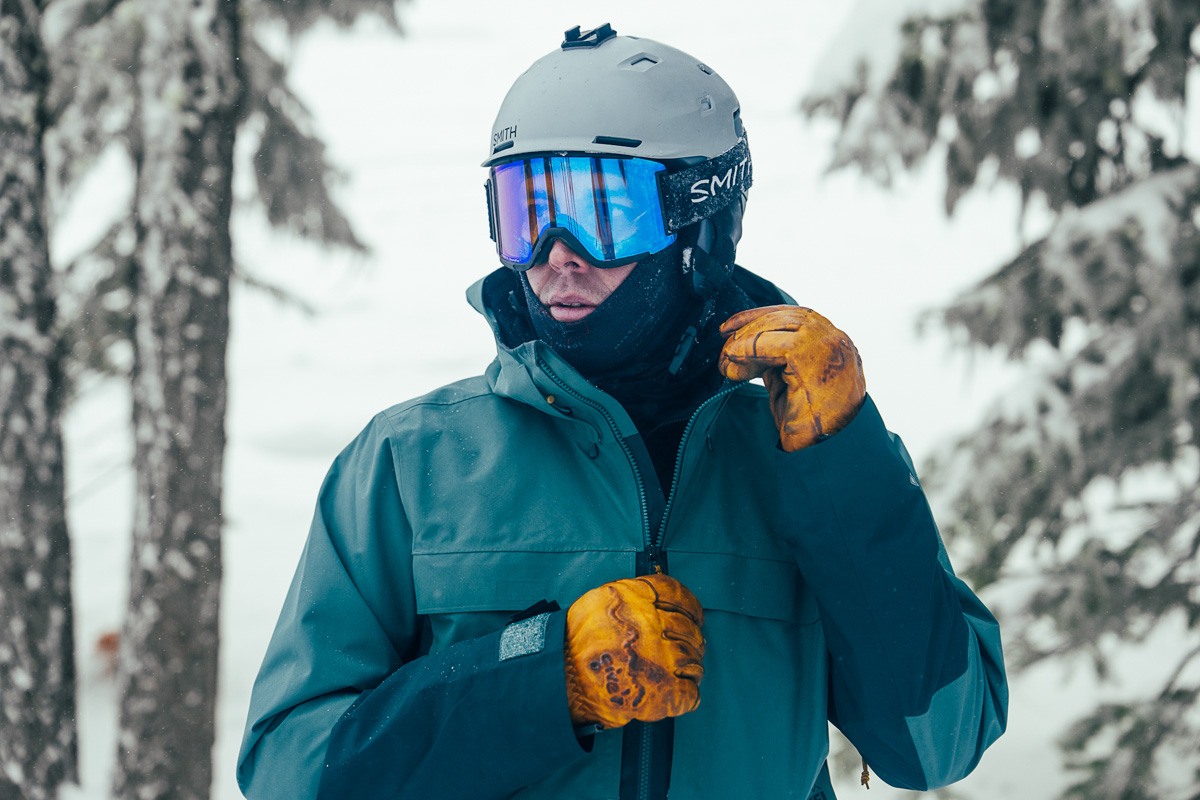
Insulated Jackets
Insulated jackets combine a protective shell with built-in insulation, offering an excellent defense against both moisture and cold. These jackets are a great match for resort skiers, providing added warmth for cold chairlift rides, windy summits, and chilly downhill runs. Most insulated ski jackets use synthetic fill, which is cheaper, more breathable, and will continue to insulate when wet (unlike down, which clumps up). High-end models, such as those featuring PrimaLoft Gold or Patagonia’s PlumaFill, offer substantial warmth with minimal bulk, while budget models tend to be heavier, bulkier, and more prone to overheating. Regardless of the fill type, insulated jackets tend to be less breathable and more restrictive compared to non-insulated hardshells, which is usually fine for resort skiing but could be a dealbreaker for backcountry adventurers.
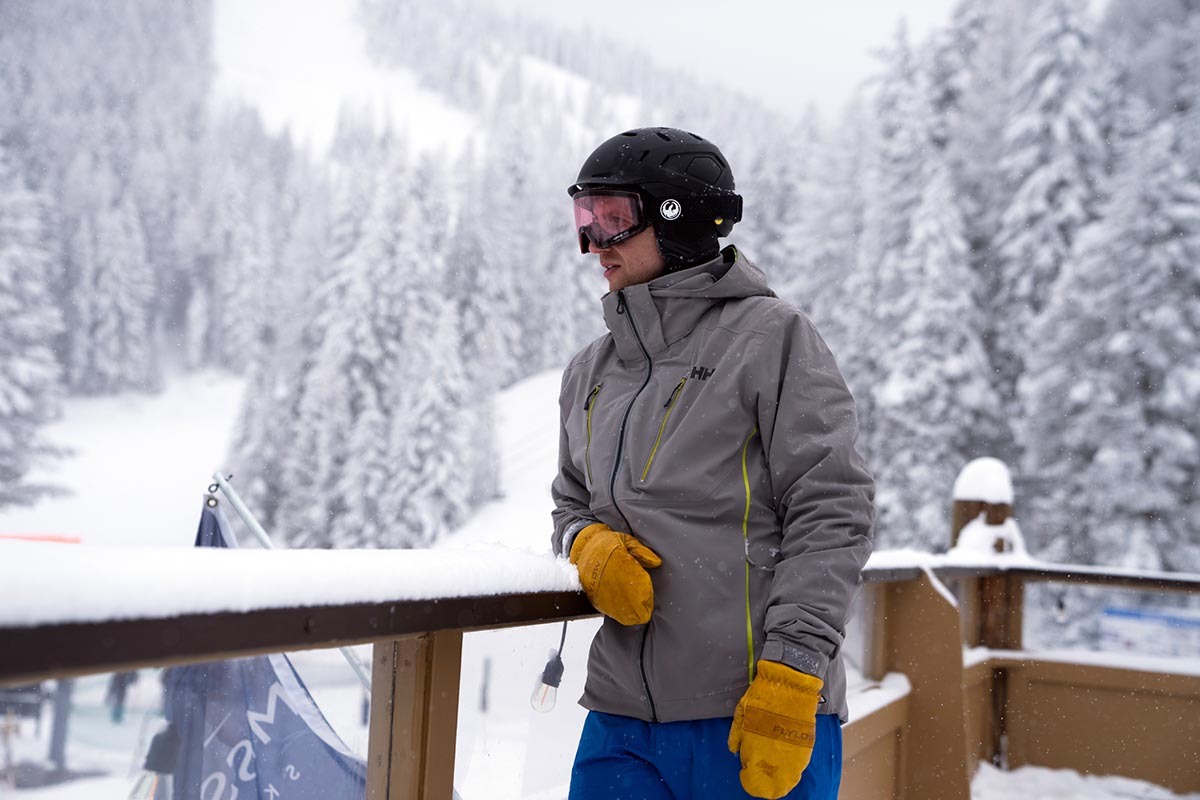
If you opt for an insulated jacket, it’s important to consider how much warmth you need. Many models have thicker insulation in the body with thinner fill in the arms and hood. While a thick and substantial jacket is ideal for cold days, it will run hot in mild conditions, which could be a problem during the warmer months of the season. We recommend moderate insulation levels, like what you get with REI's Powderbound or Helly Hansen’s Alpha 4.0 (both use a mix of 80g and 60g fill), as they allow you to add a midlayer in frigid weather without overwhelming you when the sun comes out. While heavily insulated jackets are great in certain conditions, most skiers will find more balanced options better suited for everyday use.
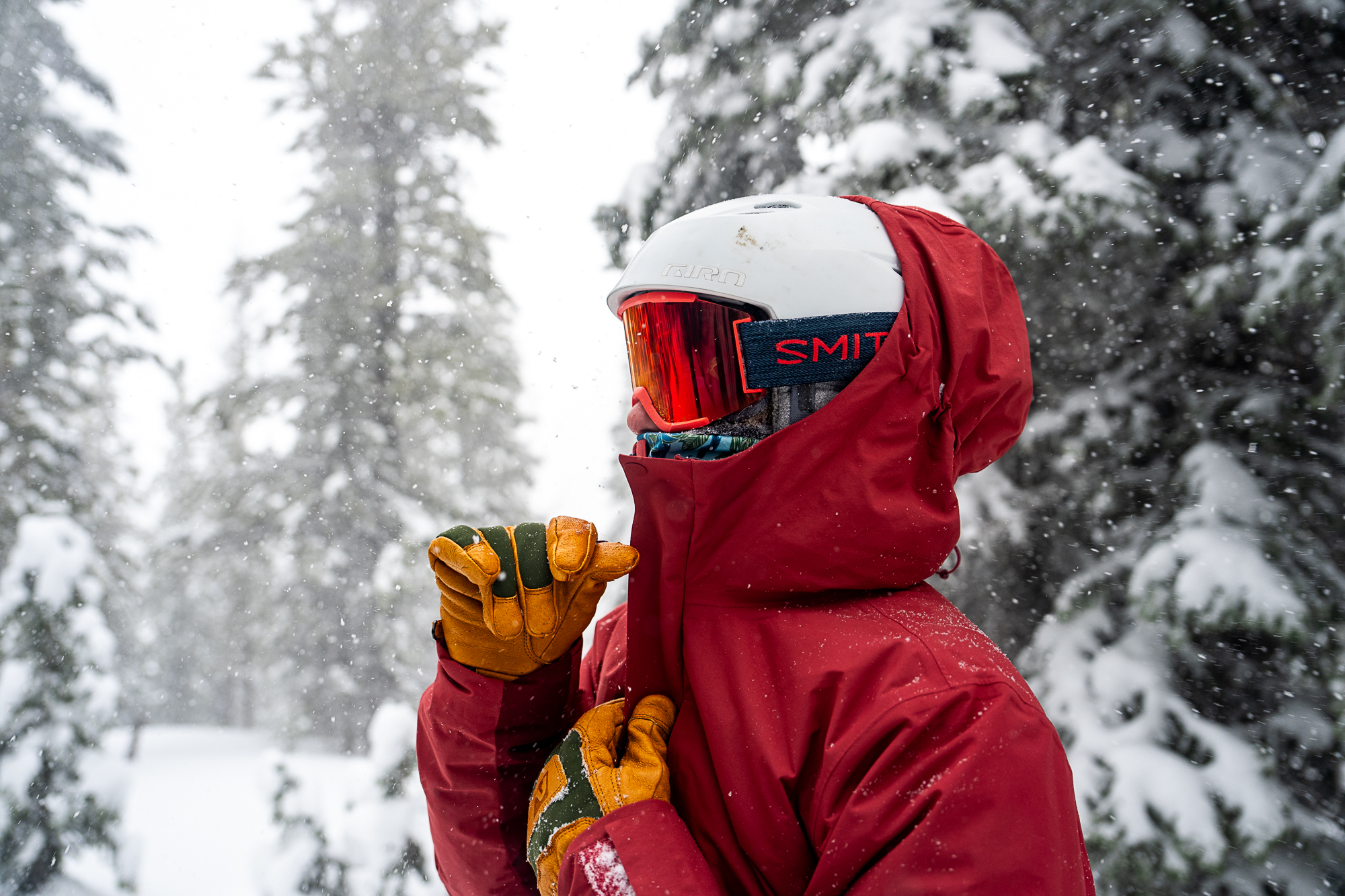
3-in-1 Jackets
Featuring an outer shell with a zip-in insulated layer, 3-in-1 jackets are popular among entry-level and casual riders. The biggest draw is affordability: You can typically find a decent 3-in-1 jacket for around $200 to $400. As their name suggests, these designs offer the versatility of three jackets in one: Wear the shell on its own on warmer days, combine it with the insulated layer for mid-winter use, or wear just the midlayer (usually a fleece or synthetic jacket) around town. The versatility is unmatched, and unliked insulated jackets, you can ditch the warming layer by simply unzipping it.
However, 3-in-1 jackets can add extra bulk and weight due to the additional zippers, and integrating the shell with the insulation can restrict movement (we’ve also found that these jackets tend to be drafty). Additionally, you cannot access the midlayer’s pockets when it’s zipped into the shell, weather protection is often middling with cheaper materials, and these jackets are far from ideal for high-exertion activities (opting for one with pit zips is a good idea). Despite these drawbacks, 3-in-1 offerings like the Columbia Bugaboo III Interchange stand out as a strong value for resort skiers on a budget or those who only hit the slopes occasionally.
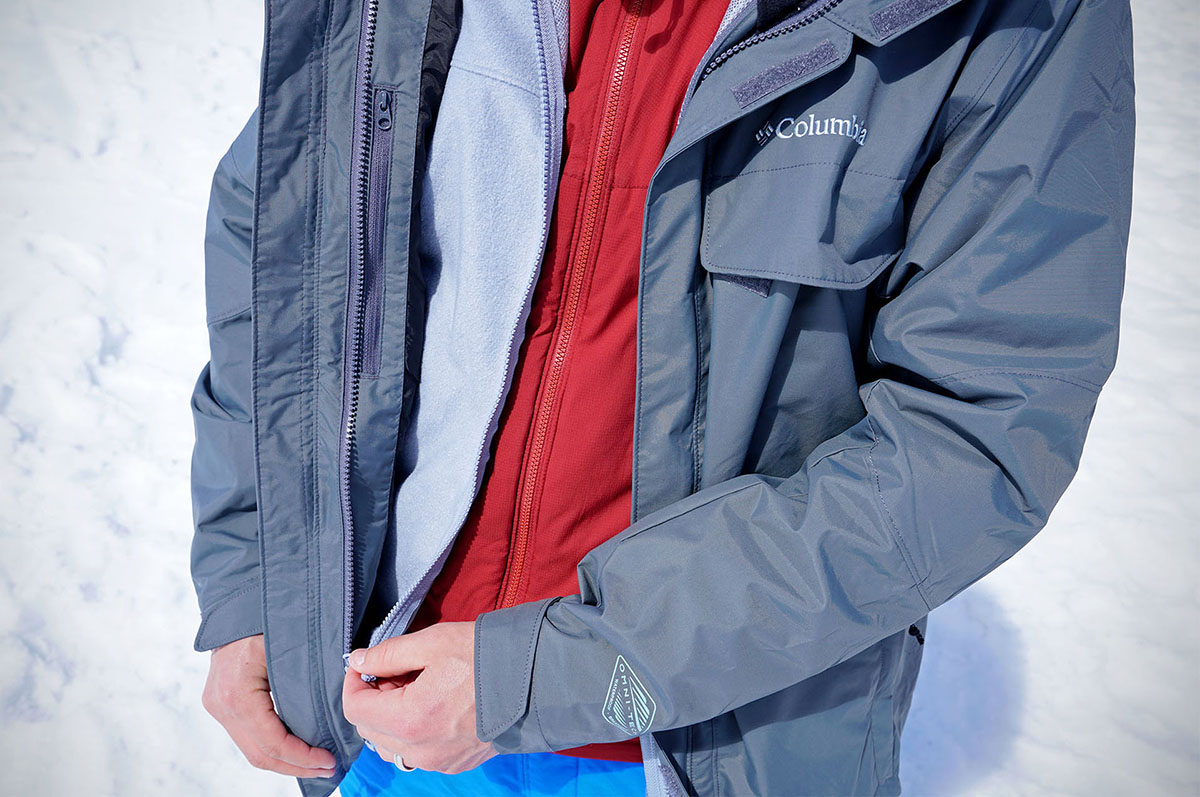
A subset of the "shell" category, softshells and hybrid hard/softshells are popular for high-output activities like ski touring. Pure softshell jackets do not have a waterproof liner, relying instead on their fabric weave or a water-resistant coating to handle snow, rain, and wind. As a result, they are the clear leaders in mobility and breathability. Their woven fabrics are stretchy, allow for great airflow, and don’t have the stiff and crinkly feel typical of hardshells. The biggest downside is the lack of weather resistance, which makes them best suited for fair-weather backcountry skiing, particularly in areas with dry snow. We didn’t include any dedicated softshells on our list above, but for a look at the market, check out our article on the best softshell jackets.
Hybrid hard/softshells combine the stretchy fabrics of softshells with a waterproof membrane for improved weather protection. Jackets like Outdoor Research's Skytour, Patagonia's SnowDrifter, and Flylow Gear's Malone/Lucy are more comfortable, breathable, and less restrictive than traditional Gore-Tex shells. However, we've found that hybrid designs typically fall short of true hardshells when it comes to all-out protection in harsh conditions. Specifically, their face fabrics tend to absorb moisture more readily, and they don’t provide the same level of security in strong winds. Still, hybrid hard/softshells have appeal in the right environments and are a great option for those looking for a quiver-of-one option for both resort and backcountry use.
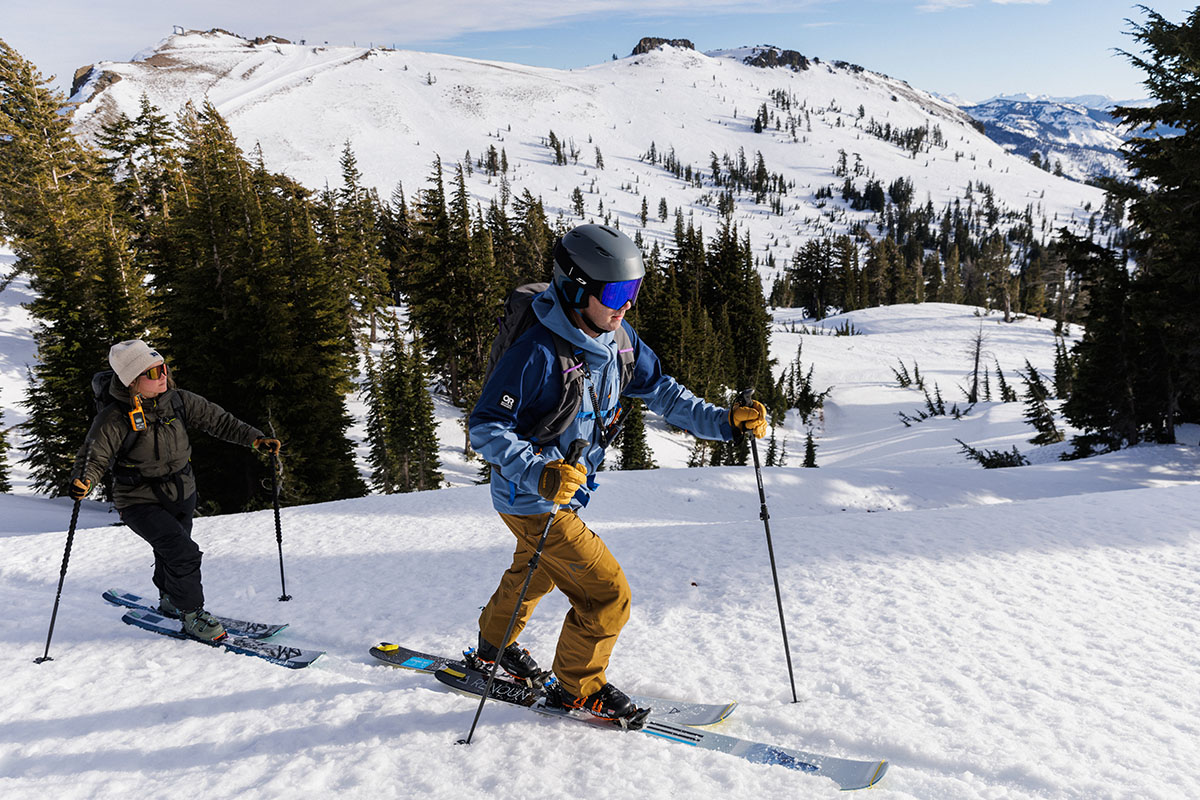
When researching ski jackets, you'll often encounter specifications indicating the number of fabric layers (either 2L or 3L). This refers to the jacket's construction: A 2-layer jacket bonds the outer fabric to a waterproof membrane, with a separate liner on the inside (often mesh), while a 3-layer jacket connects all three components together. Generally, 2-layer designs are more affordable and are often found on entry-level to mid-range models, like REI's $229 Powderbound and Patagonia’s $399 Insulated Powder Town Jacket. If you want to upgrade to a 3-layer design, expect a price tag closer to $400 to $500—or even more in the case of a high-end Gore-Tex model like the Arc’teryx Sabre and Sentinel.

In terms of performance, 2-layer jackets are popular among resort skiers because they offer solid weatherproofing and durability at a good value. However, they tend to be less breathable, and the additional liner adds extra weight and bulk. Active resort and backcountry skiers typically prefer 3-layer jackets for their better range of motion, improved comfort, and lower weight. Additionally, 3-layer designs generally offer improved breathability, and high-end Gore-Tex models provide top-notch protection in the harshest conditions. If you mostly stick to the resort, either a 2- or 3-layer jacket will suffice, but for those who often venture into more extreme conditions or spend most of their time earning their turns, we recommend opting for a 3-layer build. For a more detailed breakdown, check out our article on Ski Jacket Construction: 2L vs. 3L.
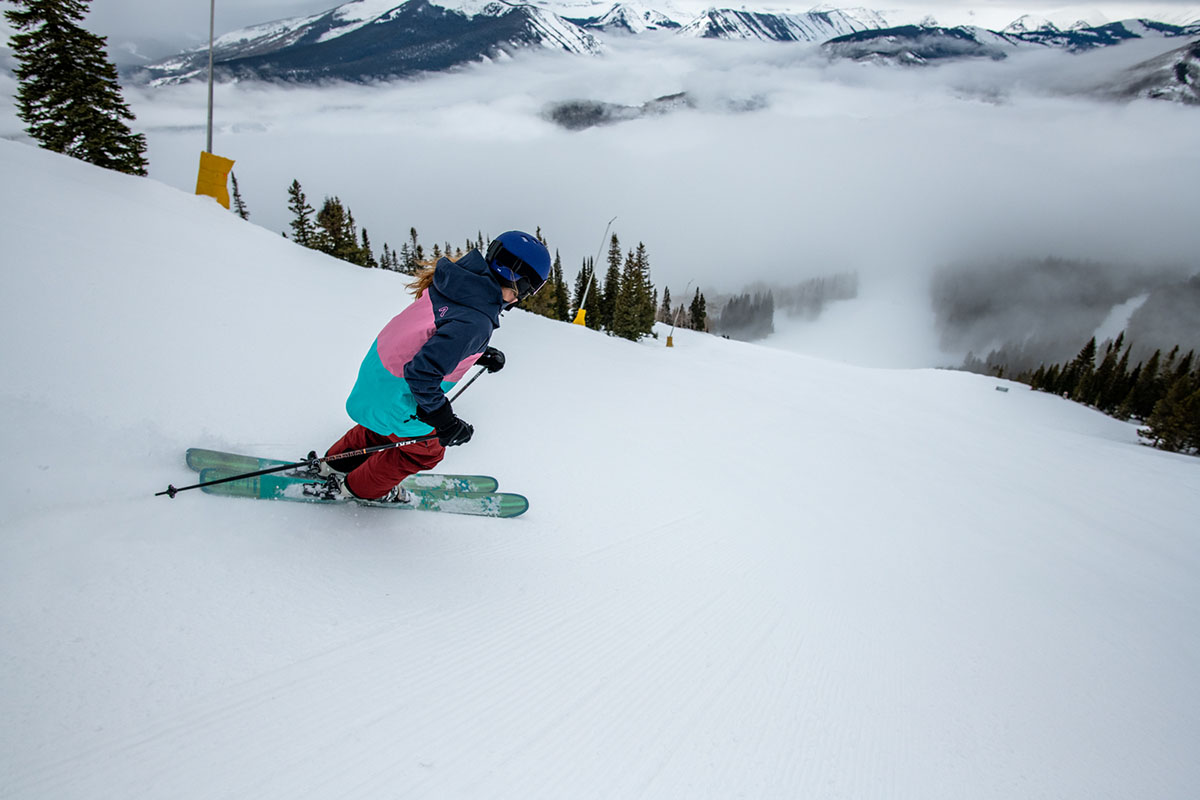
Ski jackets are generally waterproof across the board, ranging from budget-friendly options to high-end Gore-Tex (or similar) shells. One exception is a backcountry-specific softshell, which may have seam taping but will eventually let moisture in. Among waterproof options, spending more typically means a longer lifespan, as more advanced fabrics are less likely to deteriorate over time. Skiers who venture out often or find themselves in extreme backcountry conditions should consider investing in a durable Gore-Tex or Gore-Tex Pro shell. Casual resort riders, however, will likely find a more affordable option like the Columbia Bugaboo III Interchange entirely sufficient. Finally, look for jackets with a DWR (durable water-repellent) coating, which helps prevent wet snow from soaking into the exterior and eventually making its way to your layers underneath.
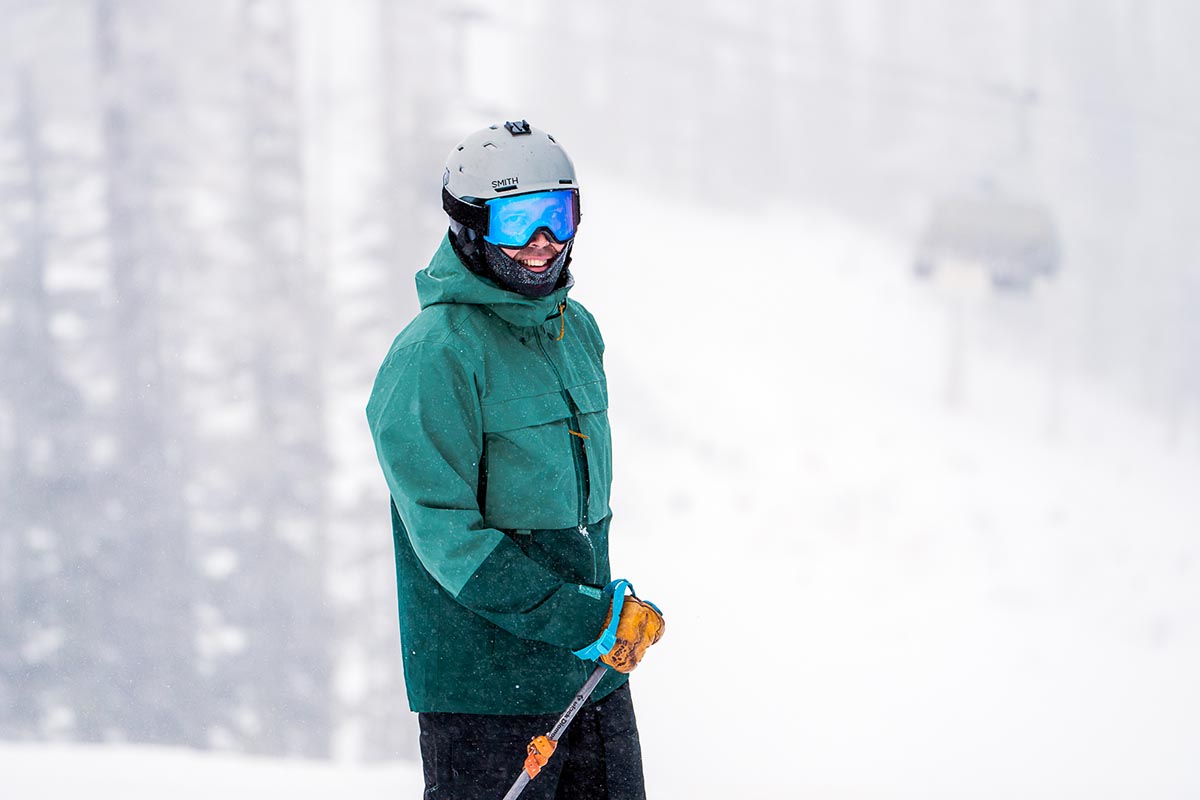
Breathability is crucial for backcountry use, though it’s slightly less of a concern inbounds. While you can certainly work up a sweat while downhill skiing, it’s easy to release heat with pit zips or by shedding a layer during a midday break at the lodge (as long as you can manage without the added insulation on the chairlift). Shell jackets are often the best breathers among waterproof designs, and particularly those with high-end 3-layer fabric constructions like Gore-Tex, eVent, Polartec NeoShell, Proflex, or Outdoor Research’s AscentShell. Generally, the more you spend on an uninsulated hardshell, the better its breathability. Softshells lead the pack in breathability because they lack a waterproof membrane, though they come with the noteworthy downside of reduced wind and water resistance.
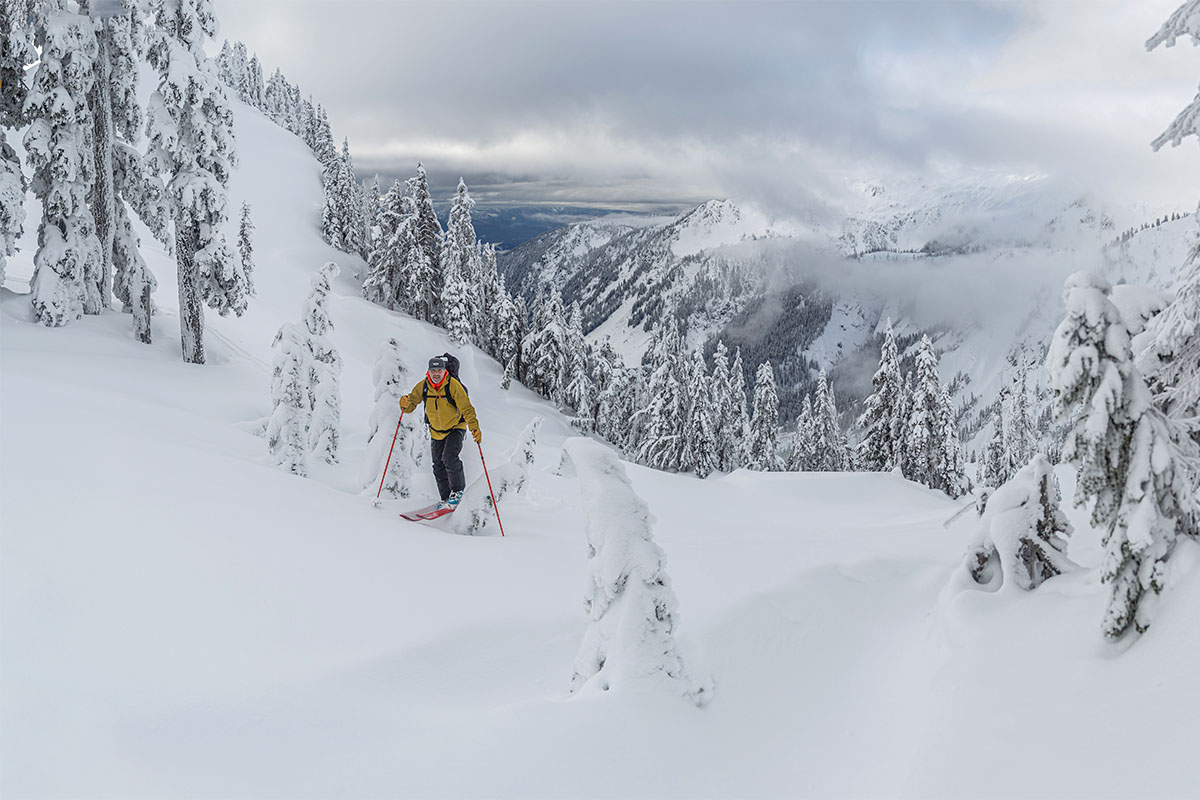
Skiing is undeniably tough on your gear, from frequent contact with chairlift seats to hiking and riding off trail. As a result, most ski-specific outer layers are built to withstand significant abuse. Fabric thickness is measured in denier (abbreviated “D”), and a higher number indicates a thicker and more durable build. Resort skiers generally benefit from a more rugged construction, with many of our favorites exceeding 100D.
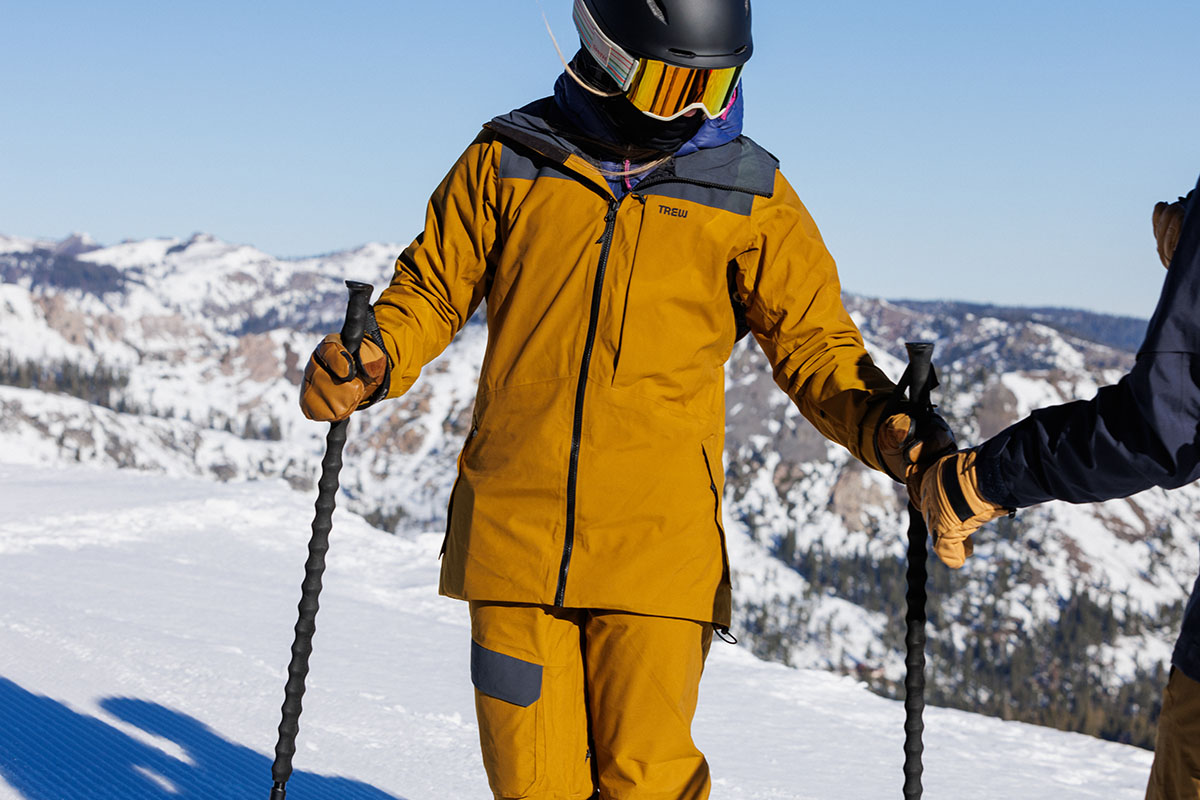
If you prioritize a lighter jacket for mobility but still want it to hold up over the long term, look for options around 80D, which strike a nice balance. Backcountry shells tend to be thinner to save weight, with popular models ranging from as low as 40D (like the Outdoor Research Skytour AscentShell, which is 40D x 65D) to about 70D. Some jackets use thicker fabrics in high-wear areas, which can be a nice way to boost longevity while still keeping weight and bulk to a minimum. Finally, keep in mind that some manufacturers don't provide this specification, but generally, you can assume resort shells will have a thicker build and touring jackets will use lighter and less durable fabrics.

The outdoor apparel industry has seen a continuous rise in the use of sustainable production practices in recent years, and ski jackets are no exception. Two key measures are the use of recycled materials and PFAS-free DWR coatings. For reference, traditional DWR treatments rely on per- and polyfluoroalkyl substances, which are known as “forever chemicals” due to their inability to break down over time. With many states stepping up to ban PFAS, the outdoor industry is exploring more environmentally friendly water- and stain-resistant solutions (for more, you can read about Patagonia’s take on the issue). Bluesign-approved fabrics are also becoming more common, ensuring that materials are sourced and produced with minimal environmental impact. Finally, many brands offer Fair Trade-certified products, which help guarantee the fair and ethical treatment of workers.
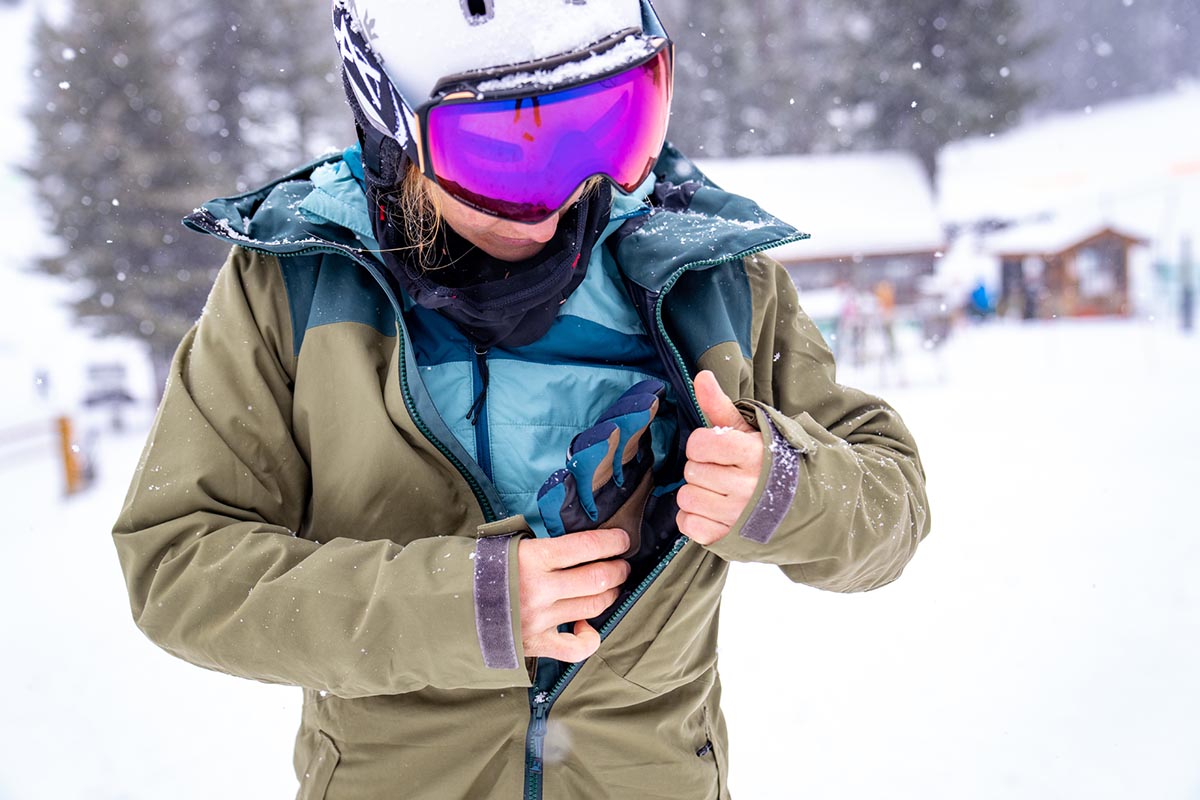
The good news is that many sustainability-minded brands are transparent about their practices, clearly indicating which methods they use. Patagonia stands out as a leader in this space: Their Storm Shift Jacket, for instance, features an entirely PFAS-free construction (including the shell fabric, membrane, and DWR finish), employs a 100%-recycled shell and lining, and is Fair Trade-certified. Other brands, such as Trew Gear, Arc'teryx, and REI, are also making notable inroads. While there’s still work to be done, the industry is moving in a positive direction, and we applaud these brands for leading the charge. A final way to shop sustainably is by purchasing high-quality products that are built to last and repairing old gear rather than replacing cheap items that only last a season or two.
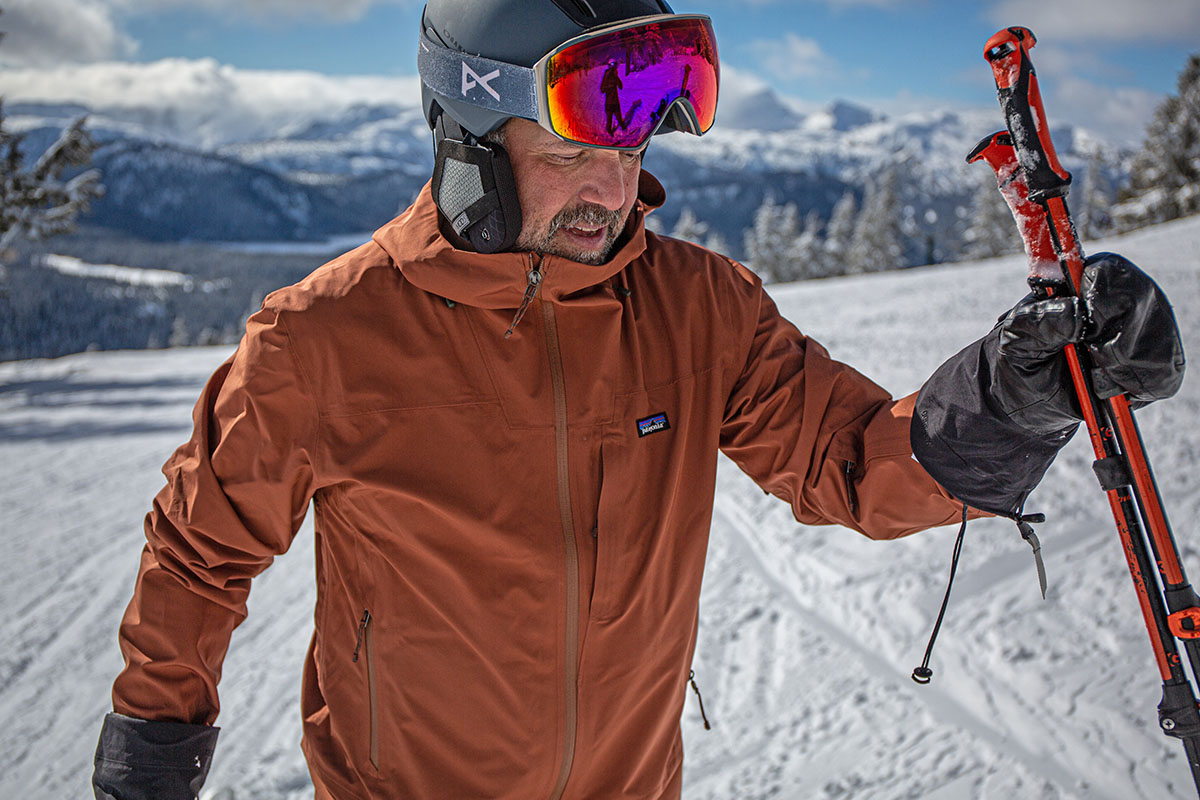
For resort skiers, the weight of a ski jacket is usually not a major concern. Most skiers can handle a few extra ounces without noticing them. In general, cheaper jackets tend to be bulkier due to their thicker, more durable fabrics. However, as soon as you start hiking or venturing off trail, the advantage of a lighter jacket becomes clear. For backcountry skiers, a lightweight hardshell is often the best choice. A couple of our favorites include the Outdoor Research Skytour AscentShell (1 lb. 6.1 oz.) and women's Patagonia SnowDrifter (1 lb. 5.2 oz.).
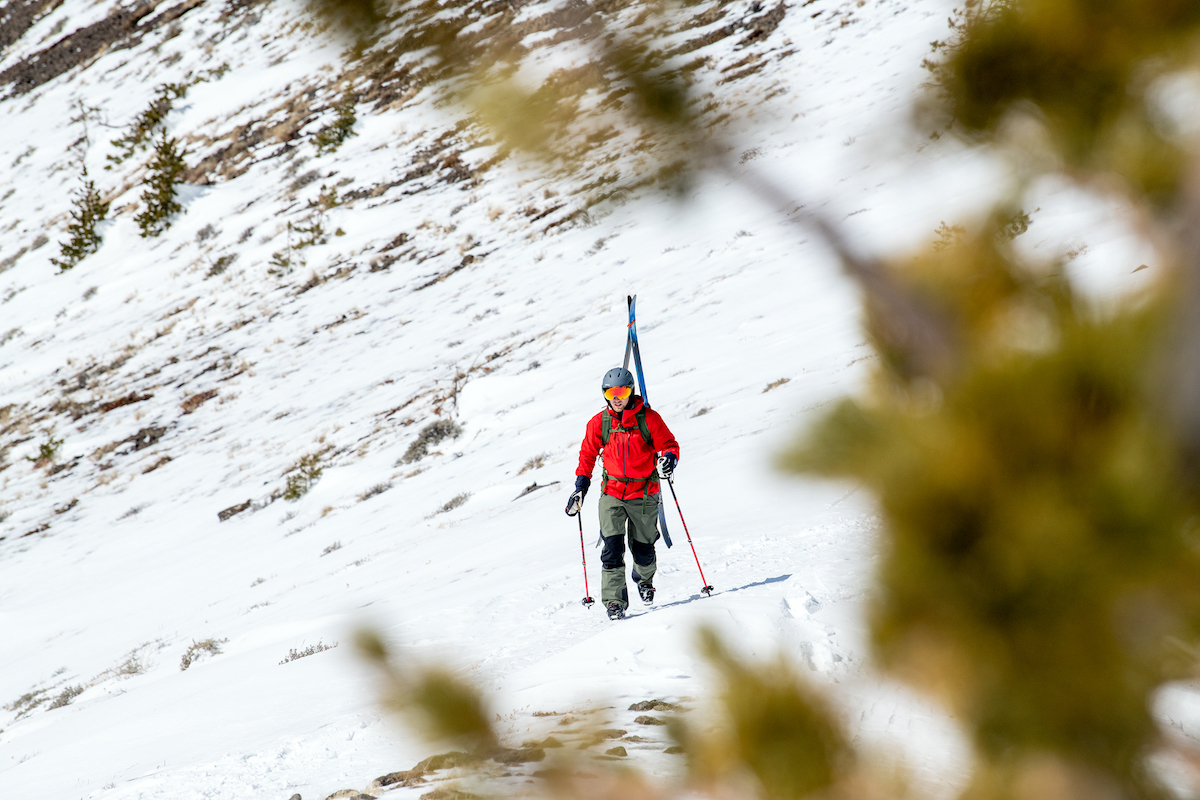
Hoods
While hoods aren't essential for most resort skiers, they provide valuable warmth and protection in certain conditions, especially on chairlifts. A good hood should be large enough to fit over a ski helmet and be adjustable enough to stay securely in place while skiing. Additionally, a well-adjusted hood should not obstruct your field of vision, which is important for your safety (and others’) on the mountain. If you plan on using your ski jacket for activities other than skiing (like wearing casually in the winter), ensure that the hood fits comfortably when you're not wearing your helmet.
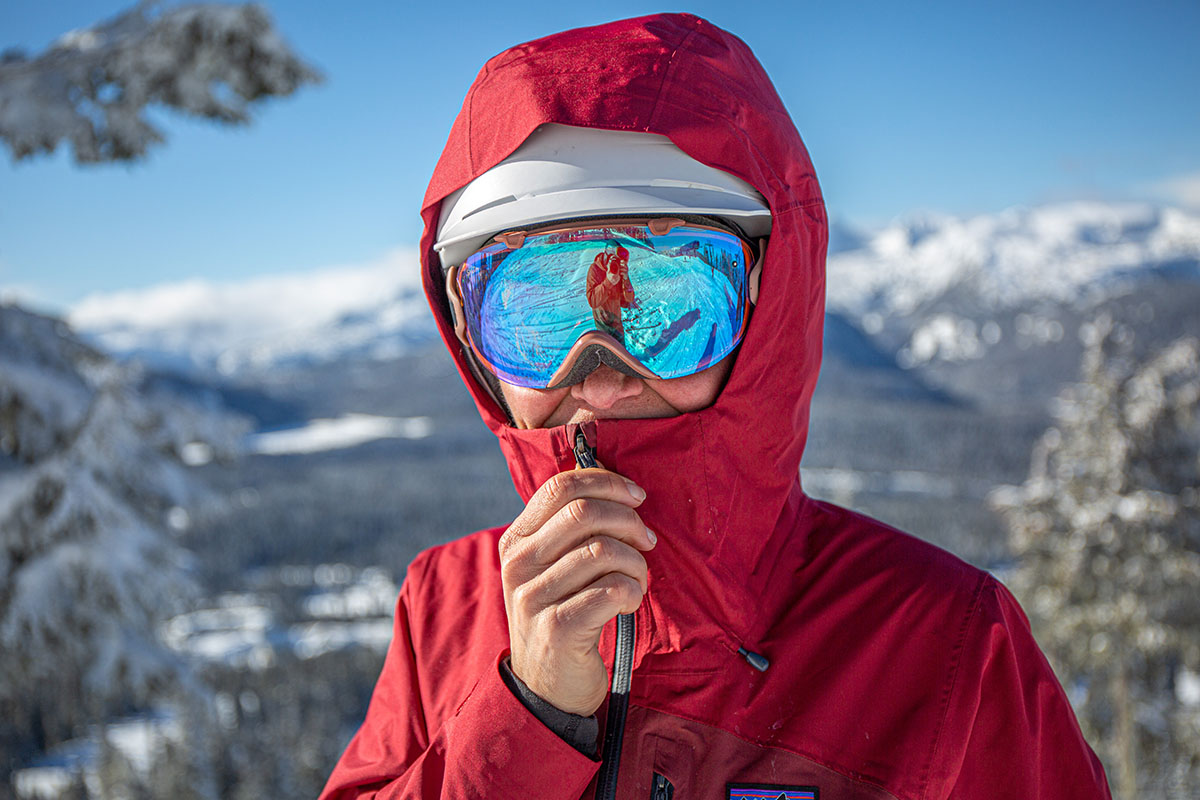
Pockets
Choosing a jacket with the right number of pockets is crucial for storage and accessibility. Most resort jackets come with hand pockets, a zippered Napoleon pocket on the chest, a pass pocket on the sleeve, and an internal pocket or two. The Napoleon pocket is especially useful for smaller items like phones, cameras, or wallets. To protect electronics, look for an interior chest pocket where your body heat can help minimize battery drainage—we especially like the "Life Pocket" on the Helly Hansen Alpha 4.0 and women's Aphelia, which is insulated with 133g PrimaLoft.
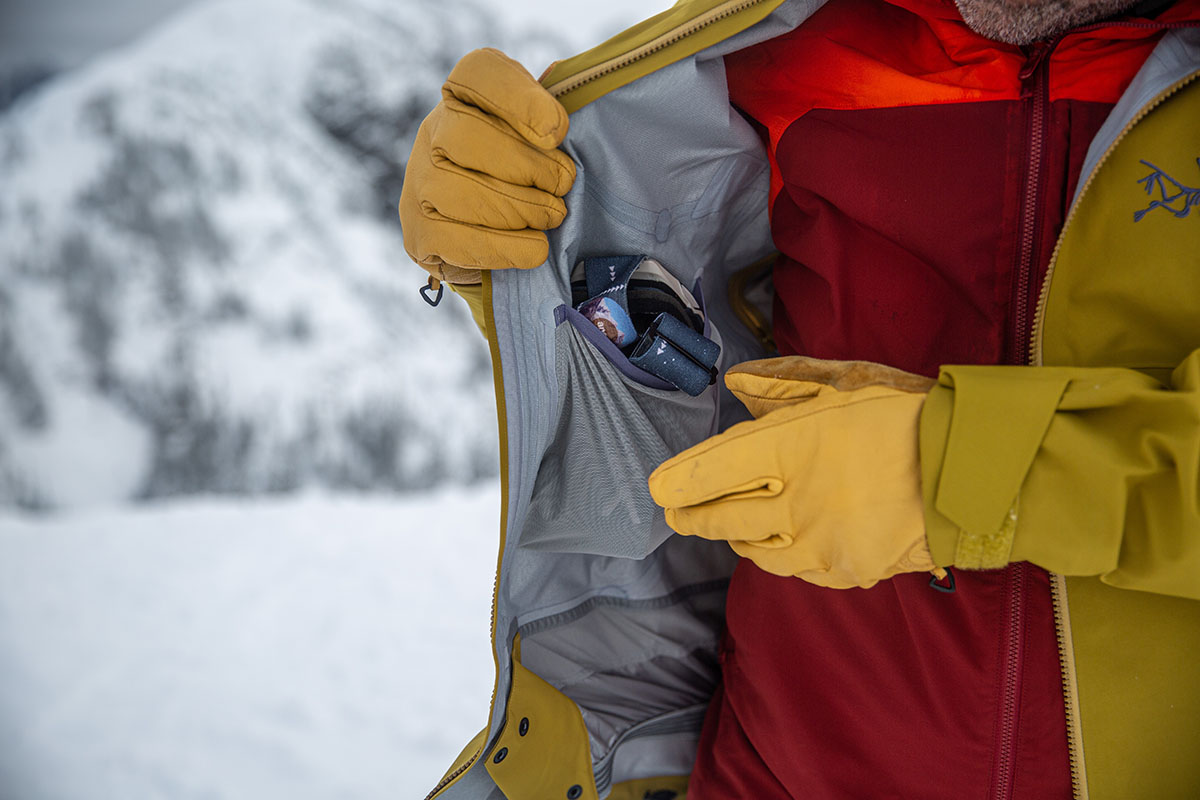
For added convenience, mesh drop-in pockets inside the jacket are great for storing gloves, goggles, or glasses while hiking or between runs. Backcountry shells tend to have simpler designs with fewer pockets to save on weight but may still include essential storage like a chest pocket and deep dump pockets for storing items like climbing skins.
Powder Skirts (Snow Skirts)
Powder skirts are a key feature for preventing snow from entering your jacket when skiing in deep powder or in the event of a fall. They generally feature elasticized fabric built into the lining of the jacket around the waist and typically secure at the front with a set or two of snaps. This helps snow from entering in the space between your pants and the bottom hem of your jacket. Some manufacturers make their snow skirts removable, which is a nice option to have if you anticipate wearing your jacket casually.
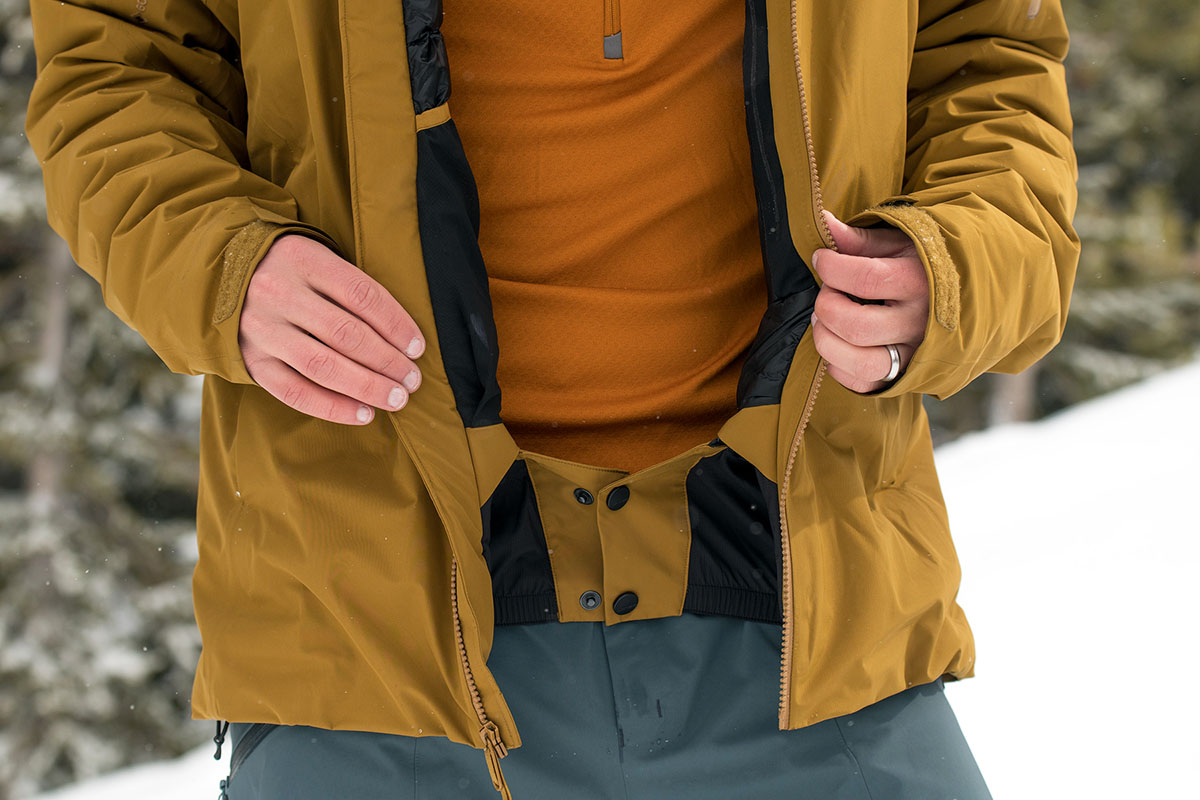
Jacket-to-Pant Attachment Systems
Jacket-to-pant attachment systems help seal out snow and cold by connecting your jacket’s powder skirt to your ski pants. This feature creates a more secure barrier but isn't a necessity. Most designs use a button or fabric loop to connect the jacket to the pants, but to make it work, you typically need to purchase pants from the same brand. Some companies, like Outdoor Research and Black Diamond, skip this feature altogether.
Pit Zips
Pit zips are essential for active skiers who are prone to building heat. These zippers, usually running from the middle of your ribcage to just above the elbow, allow you to quickly release excess heat generated while hiking, skinning, or otherwise working up a sweat. While pit zips add a bit of weight and bulk, they’re a must-have for backcountry-goers and a welcome feature on mild resort days.

Recco
A Recco reflector is a passive device intended for skiers who make their way out of bounds or into avalanche-prone areas. Built into your jacket or pants, it can be picked up by Recco detectors carried by rescue personnel (e.g., ski patrol), who can then pinpoint your location in the event of an emergency. While not a replacement for an avalanche beacon, these devices provide a nice dose of added assurance should you venture off trail. For more information on the technology, we've found Recco's website to be a helpful resource.
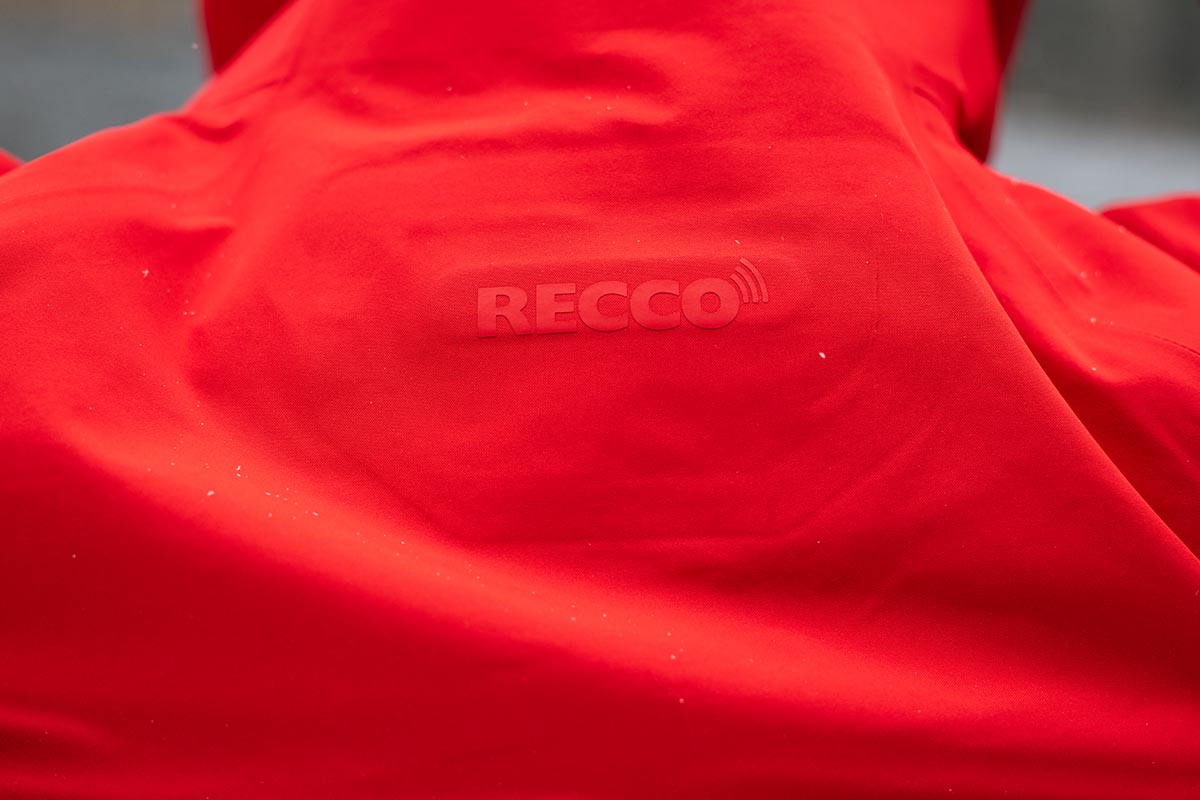
The fit of your ski jacket should match its intended use. Resort jackets, like the Patagonia Powder Town, are designed with a roomy cut to accommodate base- and midlayers and a long back length with a drop-tail hem for extra protection on cold chairlift rides. On the other hand, backcountry jackets, like the OR Skytour and Patagonia SnowDrifter, are slimmer to reduce bulk and improve range of motion, ideal for hiking and skinning. Jackets like the Arc’teryx Sabre and women's Sentinel strike a nice balance, offering enough room for layering but with excellent mobility for both resort and backcountry use.

Unless you choose a 3-in-1 jacket, you’ll need a dedicated midlayer for skiing. Midlayers can range from lightweight fleeces to heavyweight down jackets. Fleece is a classic choice and generally pretty breathable, although thicker designs can feel pretty bulky and restrictive (plus, fleece is prone to pilling and wear over time). Down provides excellent warmth relative to its weight and compresses down well for storage but loses its insulating properties when wet, while synthetic fill retains warmth even when damp. For a full spread of options, check out our article on the best midlayers.
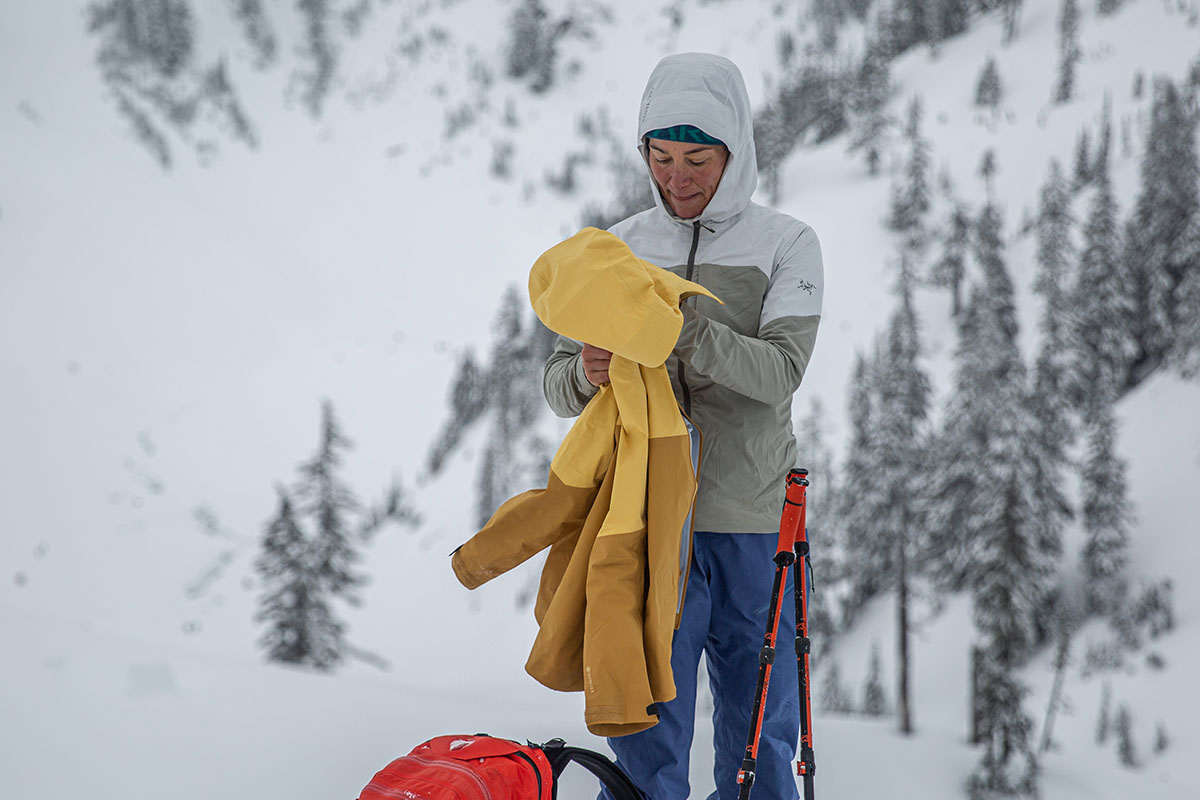
Baselayers are crucial for keeping you warm and dry. A breathable jacket will only work well if paired with a quality baselayer, so we recommend choosing wisely. Synthetic options, like those from Patagonia or Helly Hansen, are affordable and wick moisture well but are generally less soft than wool and more prone to holding onto stink. Merino wool, while expensive, excels in temperature regulation and odor resistance. For most conditions, lightweight or midweight baselayers offer a good balance of warmth and breathability.
Back to Our Top Ski Jacket Picks Back to Our Ski Jacket Comparison Tables